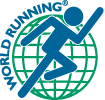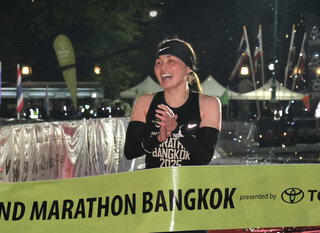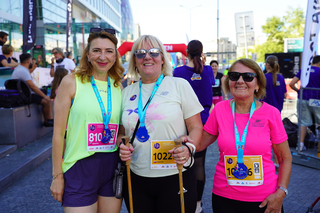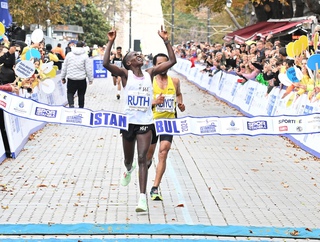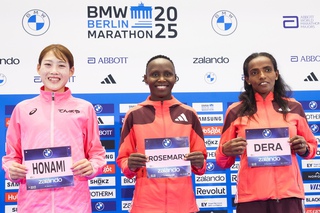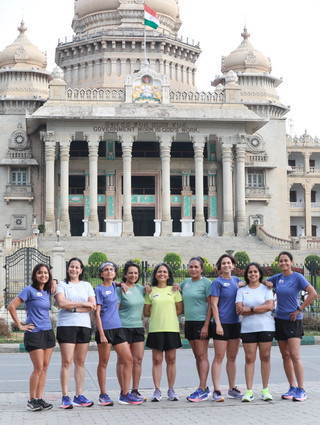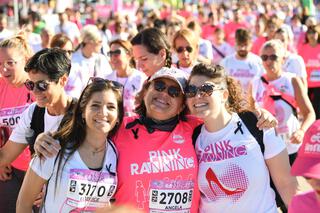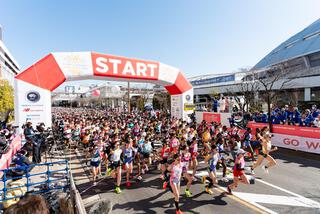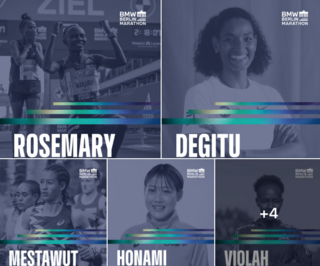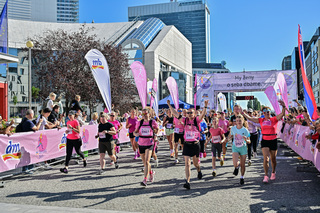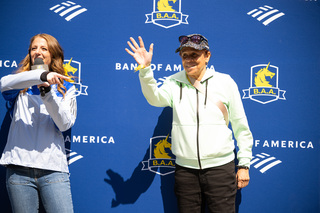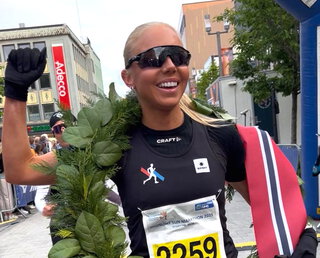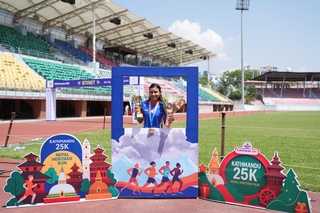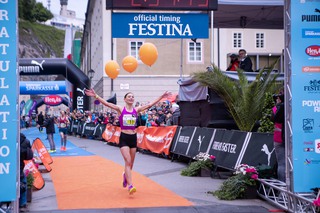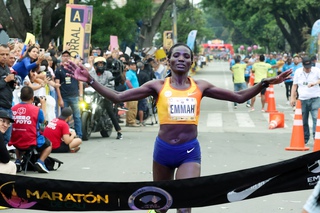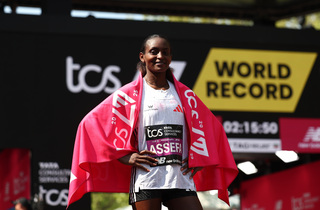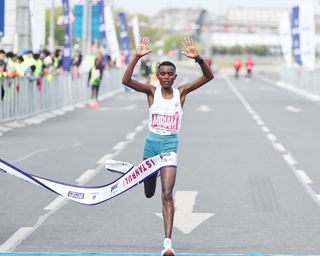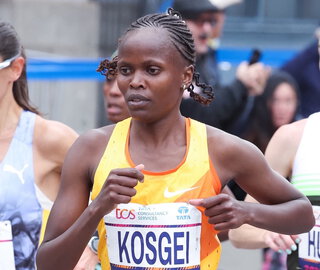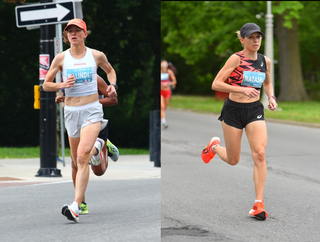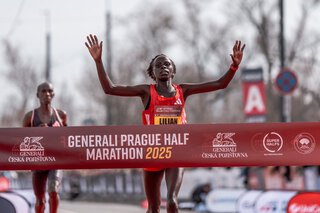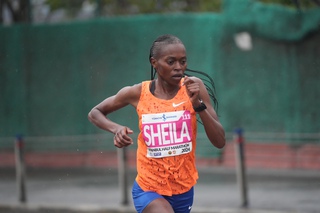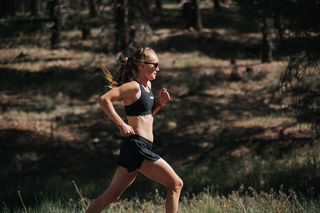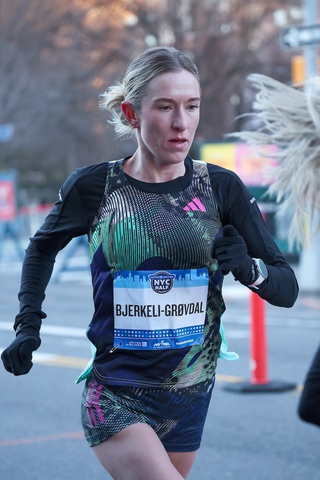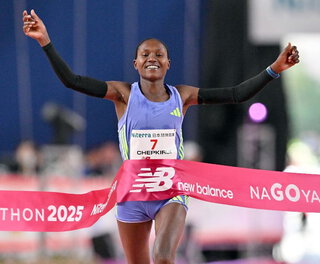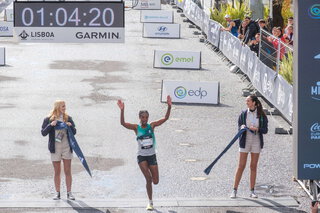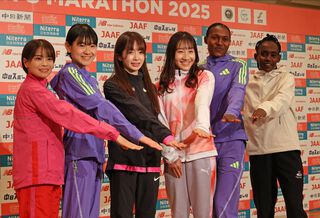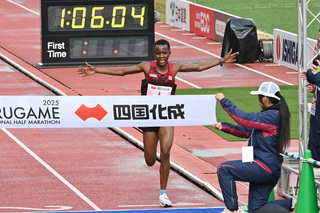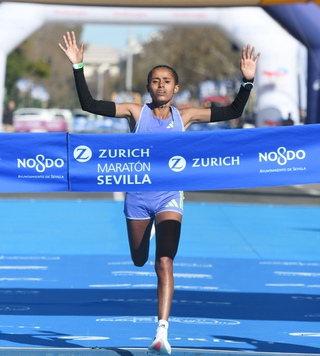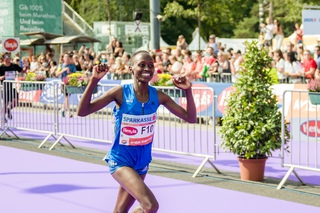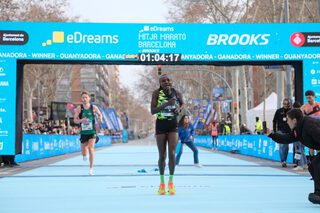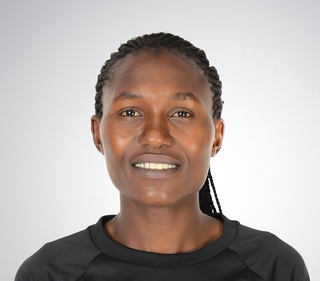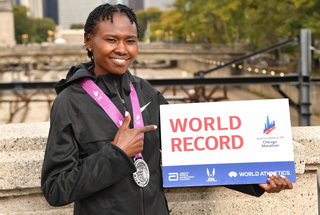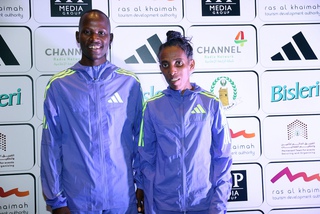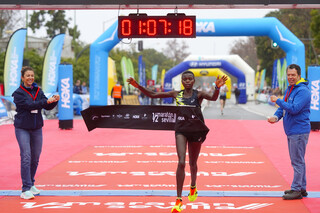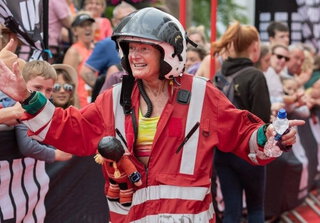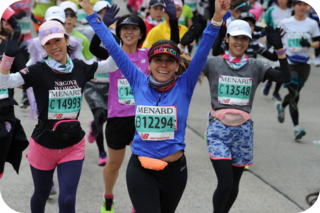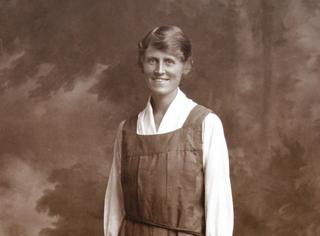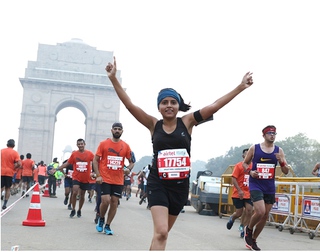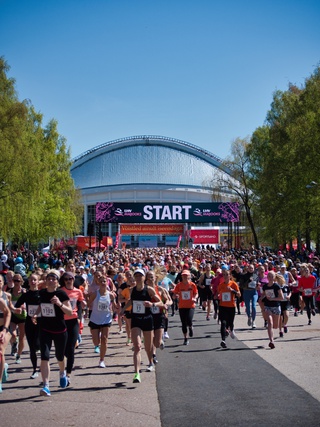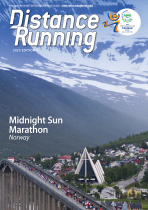AIMS Women’s Commission
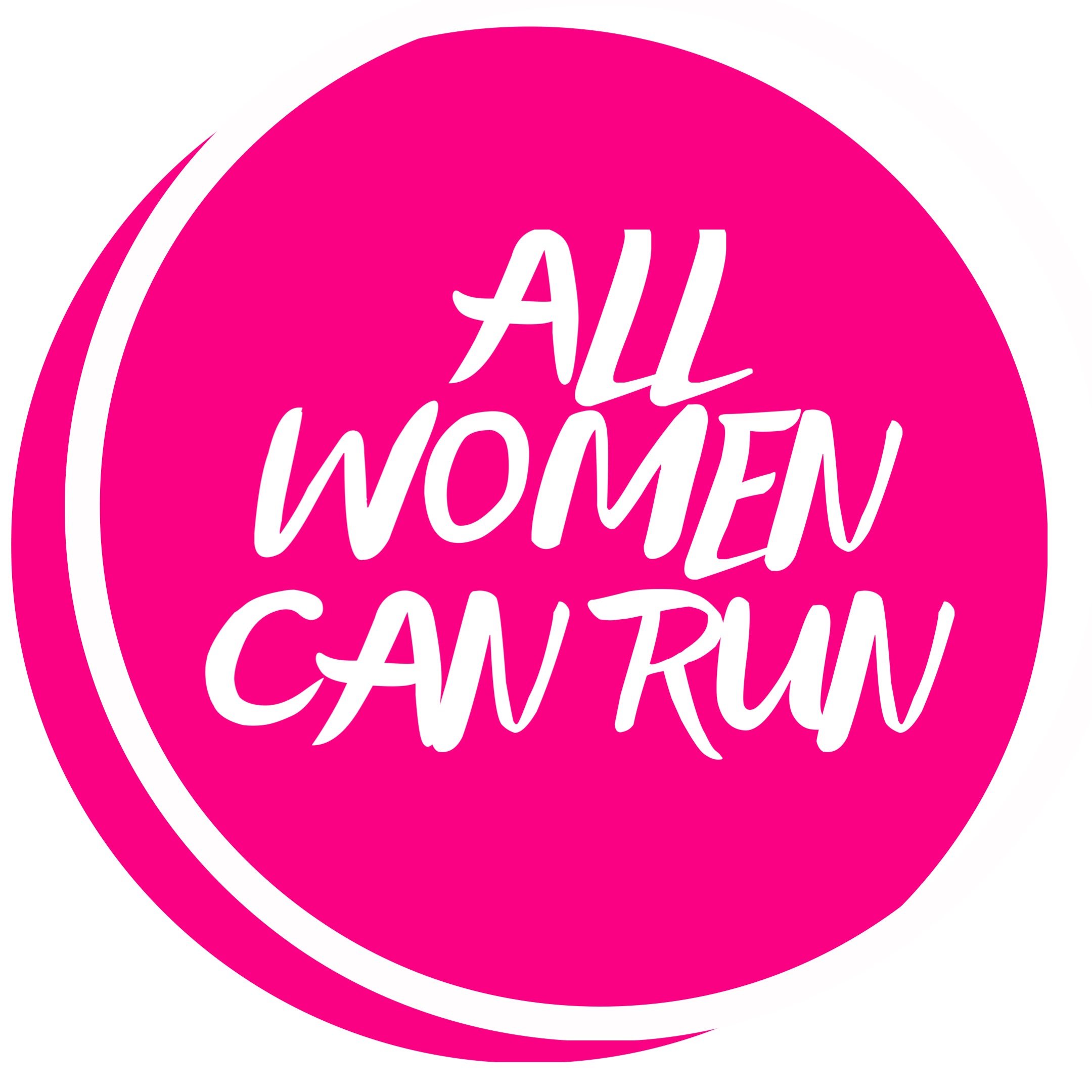
Who we are
The Association of International Marathons and Distance Races (AIMS) created the ‘AIMS Women’s Commission’, a world women’s running movement aiming to improve the participation of women in distance running throughout the world while empowering women through the sport of running.
AIMS has recognised that there is currently no formal global women’s running movement and while participation among women has increased in most parts of the world, the USA in particular, there are still areas of the world where women struggle, for different reasons, to participate in the sport of running. This Commission has been created in support of goal 5 in the United Nation’s 2030 Agenda of Sustainable Development: “Achieve gender equality and empower all women and girls.”
The Commission was launched by AIMS Vice President Martha Morales and President Paco Borao 8 March 2019, to coincide with International Women’s Day and the AIMS Member Nagoya Women’s Marathon (Sunday 10th March 2019), the largest women’s marathon in the world.
The AIMS Women’s Commission has been in development since the AIMS World Congress held in Tallinn, Estonia in September 2018, where the creation of three Commissions was announced covering the following areas – Women, Safety & Security and Environmental.
Latest news
Amazing Thailand Marathon Bangkok - Official Bangkok Capital City Marathon
Thai queen runs half marathon in Bangkok
Her Majesty Queen Suthida Bajrasudhabimalalakshana participated in the prestigious global tourism promotion race, the 8th Amazing Thailand Marathon Bangkok 2025 on Sunday.
Her Majesty completed the 21.1 km course in 2:13:40 at the Amazing Thailand Marathon 2025, promoting global tourism alongside the world record holder.
The Queen ran the Half Marathon distance (21.1 km) alongside legendary runner Eliud Kipchoge.
The event, titled ‘Run Through the City, Season 8,’ drew 20,000 runners from across the globe and was held across Pathum Wan District and the historic Sanam Luang area of Bangkok.
At 2:15 am on 30 November 2025, Her Majesty proceeded to the starting point near the Pathumwan Princess Hotel. The Queen sounded the air horn to officially start the 21.1 km Half Marathon and then commenced her run alongside Kipchoge.
Her Majesty completed the entire 21.1-kilometre course in a time of 2 hours, 13 minutes, and 40 seconds.
dm Women’s Run
dm Women’s Run on the banks of the Danube
Female energy, the joy of movement, and breathtaking views – that’s the dm Women’s Run in Bratislava!
Bratislava, the charming capital of Slovakia on the banks of the Danube, transforms into a vibrant hub of female energy and positive vibes during the dm Women’s Run.
The 13th edition welcomed a record-breaking 10,000 women, and in 2026, the capacity will expand to 12,000 runners – join us too!
Every year, more and more women join the event, but the spirit of the Mother & Daughter Run is truly exceptional. This year, nearly 900 pairs took to the start line, turning their shared run into a journey full of hugs, smiles, and quiet encouragement. The magic of this discipline lies in the connection between generations and the unforgettable experience that stays in the heart forever.
The course itself adds to the event’s unique atmosphere. Runners cross Bratislava’s iconic bridges, enjoying stunning views of the Danube River, the majestic Bratislava Castle, and the city skyline that turns into a living painting of movement and emotion.
Generations meet at the start line – from the youngest 12-year-old runners to inspiring women in their seventies. The oldest participant this year, 76-year-old Susanne Renger, completed the 5 km course in 32:57, proving that passion for running knows no limits and that movement is the best celebration of life.
From an event that welcomed just 620 women in its first edition in 2012, the dm Women’s Run in Bratislava has grown into a true running celebration that inspires thousands every year. Today, it’s not just about the kilometers – it’s about stories, friendships, and the courage to go beyond your limits. And when thousands of women fill the streets of Bratislava, the whole city runs with them.
Join us on 19th September 2026, and celebrate the power of femininity, movement, and friendship at the 14th dm Women’s Run in Bratislava!
Registration opens symbolically on 8th March – International Women’s Day.
İstanbul Marathon
Defending champion Ruth Jebet returns to Istanbul
Defending champions Dejene Debela of Ethiopia and Bahrain’s Ruth Jebet will both be returning for the Türkiye Is Bankasi Istanbul Marathon on 2nd November. They achieved impressive victories here last year in very windy conditions and will hope for better weather allowing faster times.
The 47th edition of Turkiye’s major marathon will once again feature strong fields and the event continues to be ranked as a World Athletics Gold Label Road Race, guaranteeing high standards in every aspect. The Türkiye Is Bankasi Istanbul Marathon is actually one of the oldest Gold Label marathons in the world. It has been at this level uninterruptedly since 2012 and is one of very few races that has maintained this high status for such a long period.
With exactly one month to go organisers from Spor Istanbul registered a total of 42,000 entries for the event so far, including races at shorter distances. Around 6,000 of them will compete over the classic distance on Istanbul’s unique course. Starting on the Asian side of this huge city the runners will then cross into Europe on the July 15 Martyrs Bridge and later finish in Istanbul’s old historic centre next to the Blue Mosque. Entries will still be accepted until 14th October at: https://maraton.istanbul
“We are delighted to be organizing the Türkiye Is Bankasi Istanbul Marathon, the world’s only intercontinental marathon, for the 47th time. Our Gold Label race will once again welcome great athletes. The participation of defending champions clearly demonstrates that the Istanbul Marathon is a prestigious and consistent event highly valued by elite runners. Istanbul will, as always, offer participants a truly exceptional marathon experience on an international level,”said Bilge Donuk, the new Race Director.
Dejene Debela came back from a period with injuries last year and then achieved his biggest career win at the Türkiye Is Bankasi Istanbul Marathon with 2:11:40. The 30 year-old features a strong personal best of 2:05:46 from Chicago in 2019. When the Ethiopian returns to the Bosphorus the Türkiye Is Bankasi Istanbul Marathon will be his biggest race of the year.
Two Kenyans will probably be among Debela’s strongest challengers. Rhonzas Kilimo has produced a strong marathon performance in each of the past two years. The 29 year-old was fifth in Hamburg in 2023 with 2:08:08 and then improved to 2:06:09 as the runner-up at the Seoul Marathon last year. With this PB Kilimo is the second fastest on the Istanbul start list behind Debela. Denis Chirchir has shown fine marathon performances in 2023 and 2024 as well. The 35 year-old clocked his personal best of 2:07:17 when he took second place in Hannover two years ago. In 2024 he won the Kosice Marathon with 2:07:50. Chirchir trains in Iten and is coached by renowned Italian Renato Canova. Germany’s Amanal Petros, who sensationally won silver in Tokyo’s World Championships’ marathon last month, is a friend and training partner of Chirchir.
Jake Robertson is one of a few strong non-African entrants for the race on 2nd November. The New Zealander has a 2:08:26 PB but has struggled with injuries in recent years. Robertson has not yet competed in 2025.
Returning to Istanbul Ruth Jebet is not only the defending champion but also the favourite. The former Kenyan, who competes for Bahrain since the age of 16 and then became the 2016 Olympic Champion as well as the world record holder in the steeplechase, achieved her biggest marathon victory so far in Istanbul last year. Targeting a sub 2:20:00 and then her 2:23:08 PB, neither materialized in 2024 because of the wind. But Ruth Jebet’s winning time of 2:24:45 was an extraordinary achievement taking into account the conditions. She had distanced a strong field by almost nine minutes, the biggest winning margin since 2015 in Istanbul. Back then of course the international field was far less competitive.
After taking the runner-up spot in Daegu this year with 2:25:43 Ruth Jebet will be eager to finish 2025 on a high in Istanbul. However the 28 year-old, who missed out on selection for the World Championships, will have no easy path to victory at the Türkiye Is Bankasi Istanbul Marathon. There are two athletes from Ethiopia who have personal bests close to Jebet’s 2:23:08. Tigst Getnet ran 2:23:17 in her debut marathon in Dubai where she was fifth in 2023 and Sofia Assefa’s PB stands at 2:23:33 from Amsterdam two years ago. The latter knows Ruth Jebet well since she was runner-up in that Olympic steeplechase final back in 2016. While Assefa was second best on most occasions they raced each other, the Ethiopian did manage to leave Jebet behind her three times on the track ten years ago. On 2nd November it will be the first time Jebet and Assefa challenge each other in a road race.
More information and online entry is available at: https://maraton.istanbul
BMW Berlin-Marathon
Rosemary Wanjiru and Dera Dida will target world lead
Featuring an unprecedented depth in the women’s elite field the 51st edition of the BMW Berlin-Marathon will take place on Sunday morning in the German capital.
While Rosemary Wanjiru of Kenya is the likely favourite and heads the women’s field with a PB of 2:16:14 there are seven athletes with personal bests of sub 2:20:00 – exactly the same number of women with such a PB competed in last Sunday’s World Championships’ marathon in Tokyo. Six of them have even run unter 2:19:00, which is unique for Berlin. Berlin’s super fast course might well see extraordinary times again despite a relatively warm weather forecast. The world leading time of 2:15:50 will be a target.
With over 55,000 entries from 160 nations the 51st BMW Berlin-Marathon will once again be among the world’s biggest marathons.
Rosemary Wanjiru knows the course of the BMW Berlin-Marathon well. Three years ago she ran a strong marathon debut here, finishing second in 2:18:00. “If the weather is good and I feel fine in the morning, I intend to run a very fast time,“ said the 30-year-old Kenyan during the press conference with the elite female runners. With a personal best of 2:16:14, Rosemary Wanjiru is the fastest woman on the Berlin start list.
Dera Dida, who is the wife of Olympic marathon champion Tamirat Tola, ran a personal best in the BMW Berlin-Marathon as well: In 2023 the Ethiopian finished sixth here with 2:19:24. She improved her PB this January in Dubai to 2:18:32. “I have been training intensively with Tamirat and want to run a personal best on Sunday. I am looking forward to the great atmosphere along the course and want to give something back to the spectators with a top performance,” said the 28-year-old, who is aiming to continue an unusual winning streak. Berlin’s women’s winners of the last three years are all from one training group in Addis Ababa to which Dera Dida belongs as well.
The Japanese record holder Honami Maeda is another athlete who has run below 2:19:00. She could continue the series of strong performances that Japanese athletes have shown in Berlin in the past. The highlight was Naoko Takahashi’s run in 2001, when she became the first woman to break the 2:20:00 barrier with a time of 2:19:46. Four years later, the 2004 Olympic champion, Mizuki Noguchi, won in Berlin with a time of 2:19:12. This Japanese record stood for 19 years. And it was Honami Maeda who broke the mark in Osaka in January 2024 with a time of 2:18:59. “Berlin is a restart for me because I was injured for a long time. I will run as fast as possible,“ said Honami Maeda, who will be running her first marathon since breaking the Japanese record.
Unfortunately Norwegian Karoline Grovdal had to pull out at short notice due to an illness. A German athlete could now be the fastest European in Berlin: Domenika Mayer was the most consistent German marathon runner in the past couple of years. The 34-year-old ran her personal best of 2:23:47 at the BMW Berlin-Marathon two years ago. With this performance she qualified for the 2024 Olympic Games where she was the best German runner in 28th place. “I am looking forward to the great atmosphere in Berlin and want to try to run a personal best. I had some health problems during my preparation, but I got back on track just in time,“ said Domenika Mayer, who is the third fastest German marathon runner ever.
Fabienne Königstein, who has a 2:25:48 PB, is also expected to be strong. After suffering of injuries and illnesses for several years she came back promisingly this spring. “I really enjoy my running,“ said the 32-year-old after finishing fourth in the Vienna Marathon. “I am well prepared and want to run under 2:23:00 on Sunday.“
Deborah Schöneborn, who competes for Marathon Team Berlin, which is associated with the BMW Berlin-Marathon, is the second fastest German on the start list with her PB of 2:24:54. However, she has suffered from recurring foot problems over the last year and a half. “I am glad that I can start the race in good health and I am looking forward to it,“ said the 31-year-old, who will be running her tenth marathon on Sunday.
Featuring an unprecedented depth in the women’s elite field the 51st edition of the BMW Berlin-Marathon will take place on Sunday morning in the German capital.
While Rosemary Wanjiru of Kenya is the likely favourite and heads the women’s field with a PB of 2:16:14 there are seven athletes with personal bests of sub 2:20:00 – exactly the same number of women with such a PB competed in last Sunday’s World Championships’ marathon in Tokyo. Six of them have even run unter 2:19:00, which is unique for Berlin. Berlin’s super fast course might well see extraordinary times again despite a relatively warm weather forecast. The world leading time of 2:15:50 will be a target.
With over 55,000 entries from 160 nations the 51st BMW Berlin-Marathon will once again be among the world’s biggest marathons.
Rosemary Wanjiru knows the course of the BMW Berlin-Marathon well. Three years ago she ran a strong marathon debut here, finishing second in 2:18:00. “If the weather is good and I feel fine in the morning, I intend to run a very fast time,“ said the 30-year-old Kenyan during the press conference with the elite female runners. With a personal best of 2:16:14, Rosemary Wanjiru is the fastest woman on the Berlin start list.
Dera Dida, who is the wife of Olympic marathon champion Tamirat Tola, ran a personal best in the BMW Berlin-Marathon as well: In 2023 the Ethiopian finished sixth here with 2:19:24. She improved her PB this January in Dubai to 2:18:32. “I have been training intensively with Tamirat and want to run a personal best on Sunday. I am looking forward to the great atmosphere along the course and want to give something back to the spectators with a top performance,” said the 28-year-old, who is aiming to continue an unusual winning streak. Berlin’s women’s winners of the last three years are all from one training group in Addis Ababa to which Dera Dida belongs as well.
The Japanese record holder Honami Maeda is another athlete who has run below 2:19:00. She could continue the series of strong performances that Japanese athletes have shown in Berlin in the past. The highlight was Naoko Takahashi’s run in 2001, when she became the first woman to break the 2:20:00 barrier with a time of 2:19:46. Four years later, the 2004 Olympic champion, Mizuki Noguchi, won in Berlin with a time of 2:19:12. This Japanese record stood for 19 years. And it was Honami Maeda who broke the mark in Osaka in January 2024 with a time of 2:18:59. “Berlin is a restart for me because I was injured for a long time. I will run as fast as possible,” said Honami Maeda, who will be running her first marathon since breaking the Japanese record.
Unfortunately Norwegian Karoline Grovdal had to pull out at short notice due to an illness. A German athlete could now be the fastest European in Berlin: Domenika Mayer was the most consistent German marathon runner in the past couple of years. The 34-year-old ran her personal best of 2:23:47 at the BMW Berlin-Marathon two years ago. With this performance she qualified for the 2024 Olympic Games where she was the best German runner in 28th place. “I am looking forward to the great atmosphere in Berlin and want to try to run a personal best. I had some health problems during my preparation, but I got back on track just in time,” said Domenika Mayer, who is the third fastest German marathon runner ever.
Fabienne Königstein, who has a 2:25:48 PB, is also expected to be strong. After suffering of injuries and illnesses for several years she came back promisingly this spring. “I really enjoy my running,” said the 32-year-old after finishing fourth in the Vienna Marathon. “I am well prepared and want to run under 2:23:00 on Sunday.”
Deborah Schöneborn, who competes for Marathon Team Berlin, which is associated with the BMW Berlin-Marathon, is the second fastest German on the start list with her PB of 2:24:54. However, she has suffered from recurring foot problems over the last year and a half. “I am glad that I can start the race in good health and I am looking forward to it,“ said the 31-year-old, who will be running her tenth marathon on Sunday.
Wipro Bengaluru Marathon
Women CXO leaders as ambassadors at Wipro Bengaluru Marathon
Bengaluru, celebrated as the IT Capital of India and equally revered as the Running Capital of India, is set to witness yet another milestone moment as the 12th edition of the Wipro Bengaluru Marathon gears up for September 21st.
With over 30,000 runners from 26 countries expected to participate, the city’s most prestigious running event is all set to showcase not just athletic excellence, but also the leadership and inspiration drawn from corporate India.
This year, a special spotlight shines on women CXO leaders from leading global organizations like Wipro, Kyndryl, Cisco, Ernst & Young, Siemens, Wells Fargo, Qualcomm, etc are stepping forward as ambassadors of the marathon. Their participation goes beyond the boardroom, symbolizing resilience, inclusivity, and the growing culture of fitness in corporate corridors.
As leaders in their respective industries, these women embody the very spirit of the marathon—discipline, perseverance, and community engagement. Their presence underscores the strong synergy between Bengaluru’s thriving corporate ecosystem and its vibrant running community.
Speaking about the initiative, race promoters emphasized that having women leaders at the forefront reflects the marathon’s values of diversity, empowerment, and collective progress. Just as these leaders drive transformation in the technology and business world, they also serve as role models inspiring thousands of runners to push boundaries and aim higher.
The Wipro Bengaluru Marathon has long been more than just a race—it is a celebration of the city, its people, and its spirit. The involvement of these CXO-level women ambassadors reinforces Bengaluru’s dual identity as a hub of innovation and endurance.
On September 21st, when the runners take their strides past landmarks like Vidhana Soudha, MG Road, and Cubbon Park, they will do so with the encouragement of leaders who exemplify what it means to balance professional excellence with personal passion.
Ravenna sees “Pink Running” event
Get your sneakers ready and let’s paint Ravenna pink together!
On Sunday, September 28, 2025, the highly anticipated Pink RUNNING returns to the Darsena di Città, an event combining sport, fun, and solidarity.
Join us: it’s not just about running or walking, but doing it for an important cause, to send a strong and shared message against violence against women.
Because it will be important for everyone: not to run, not to walk, but simply to be there!
WHY IS IT IMPORTANT TO PARTICIPATE?
To say NO to violence: together we can make our voices heard.
To feel good: sharing exercise, smiles, and friendship is good for the body and the spirit.
To help in a concrete way: a portion of the proceeds will be donated to Linea Rosa, for the children of women receiving shelter and hospitality in the municipalities of Ravenna, Cervia, and Russi.
You choose! Run or walk, 5 or 10 km!
The important thing is to be there, at your own pace!
DON’T SIT WHILE WATCHING!
Every step you take will be for a better future.
ONLINE REGISTRATION: open until September 24th at 12:00 PM https://maratonadiravenna.com/wp/pink-ranning/
Nagoya Women’s Marathon
International entry for Nagoya Women’s Marathon opens
International entries for the Nagoya Women’s Marathon 2026, scheduled for Sunday, March 8, 2026, will open on Tuesday, August 12, 2025.
Held annually on the second Sunday of March in Nagoya, Japan, the Nagoya Women’s Marathon is the largest women’s marathon in the world, officially recognized by Guinness World Records. As a World Athletics Platinum Label race, it has earned global acclaim for its exceptional quality and organization. This year, 20,000 women runners, including 3,500 from overseas, will come together to shine on the one-of-a-kind stage that empowers and celebrates all women.
One of the highlights of the event is the special finisher’s prize. Since the 2025 race, each finisher receives an individually handcrafted crystal tumbler made by Baccarat, a French luxury brand with over 260 years of history. The 2026 design will be unveiled on stage at the Marathon Expo the day before the race.
Once seen as a solitary and stoic personal challenge, the marathon and distance running is now increasingly embraced as a “sport of connection,” where runners share common goals and support one another in achieving them. As a women-only race, the Nagoya Women’s Marathon is especially beloved for the inspiring camaraderie it fosters among participants. Many runners have shared stories of being uplifted by strangers on the course, such as moments of encouragement and mutual support that helped them stay strong and cross the finish line together.
The race provides an exceptional environment that supports runners in completing the marathon safely and comfortably, with top-level medical care, a world-leading number of clean toilets, and spacious changing areas. With a generous seven-hour time limit and a relatively flat course, it is an ideal choice for first-time marathoners.
Why not take on a special 42.195 km challenge in Nagoya next spring? We warmly welcome women runners from around the world to join us. Men accompanying female participants are also invited to take part in the Nagoya City Marathon, which offers a mixed half marathon and the Nagoya RUN (7.758 km race), both held on the same day.
BMW Berlin-Marathon
Women to watch in Berlin
The women’s field at Berlin Marathon is on fire this year, stacked with serious talent and massive potential, say the race organisers.
Norway’s Karoline Grovdal is very promising European runner who will make her second attempt at the classic distance after dropping out in her debut race in Hamburg earlier this year. A number of athletes for the men’s elite field were released earlier. More than 50,000 runners are expected to participate in the 51st BMW BERLIN-MARATHON.
Rosemary Wanjiru returns to the race where her marathon career got off to an impressive start in 2022. Three years ago she finished second in Berlin in 2:18:00. Six months later Wanjiru won the Tokyo Marathon and in 2024 she was second there with her current best time of 2:16:14. The Kenyan intended to run the 50th BMW BERLIN-MARATHON a year ago but had to withdraw due to an injury.
Degitu Azimeraw is another runner in Berlin’s elite field who has already run well under 2:20:00 and she as well has already beaten this mark several times. The 24-year-old Ethiopian ran her best race to date in London 2021. There she achieved a surprise runner-up position with 2:17:58.
Like Rosemary Wanjiru Ethiopia’s Mestawut Fikir is also returning to Berlin. After the 25-year-old won her marathon debut in Paris a year ago, she improved to 2:18:48 in Berlin taking second place.
Karoline Grovdal took the half marathon at the European Athletics Championships in Rome last summer. While this was her biggest career victory so far, the 35 year-old also won the European cross country title for three years in a row, from 2021 to 2023. Karoline Grovdal ran her marathon debut in Hamburg this April, hoping to make an instant impact by attacking the famous Norwegian national record of Ingrid Kristiansen. Back in 1985 Kristiansen ran a spectacular world record time of 2:21:06 in London. That global mark stood for over a decade and is still the Norwegian record. Grovdal was unlucky in Hamburg since she had to drop out due to a shoe problem. She will now hope to bounce back in Berlin.
dm Women’s Run
dm Women’s Run in Bratislava
Picture thousands of women running side by side—each with her own story,
motivation, and energy.
What connects them all? The joy of movement, the power of community, and a shared celebration of what it means to be a woman.
With 10,000 women at the start line, the dm women’s run is more than a race. It’s a moment of unity, support, and pride. Whether chasing a personal best or simply enjoying every step, every woman belongs here.
No limits. No judgments. Just pure joy in motion.
Boston Marathon presented by Bank of America
Another historic day for Boston Marathon
This year’s Boston Marathon presented by Bank of America played out on an historic and sun-filled Patriots’ Day, with Kenyan champions Sharon Lokedi and John Korir etching their names in marathon lore.
Lokedi’s course record 2:17:22 happened to come on the 50th anniversary of another monumental moment in women’s race history: a trailblazing run by Marilyn Bevans.
It was on 21 April 1975, that Bevans, a native of Maryland, ran 2:55:52 to place fourth at the 79th Boston Marathon. Bevans’ perseverance and determination made history, as she became the first U.S.-born African American woman to break three hours in the marathon. She’d go on to finish second at Boston two years later in 1977, running 2:51:12.
Bevans’ mark on running and Boston history was celebrated on this Marathon Monday (21 April) as she was recognized at the finish line and took part in a special event held by the Black Unicorn Marathoners, a group that celebrates and connects BIPOC runners associated with the Boston Marathon, from qualifiers and charity runners to invited entrants and alumni.
On race day, a team of four athletes – Alisa Harvey, Michelle Wheeler, Erica Stanley-Dottin, and Tay Artis – ran in Marilyn’s honor celebrating five decades since her pioneering feat. Wheeler placed 12th in the wheelchair division and wore her Black Unicorn Marathoners uniform and medal with pride, noting on Instagram that “It was also an incredible honor to spend time with trailblazers, [1975 wheelchair champion] Bob Hall and Marilyn Bevans. To Ms. Bevans, thank you for allowing me represent you today.”
Back in 2013 Bevans was inducted into the National Black Marathoners Association Hall of Fame, and she continues to be an inspirational force showcasing the power of running for athletes of all backgrounds. At Boston she mentioned focusing on an upcoming 10K, where she’s aiming to have fun and channel some of her speed from 50 years ago.
Midnight Sun Marathon
New women’s course record set at Midnight Sun Marathon
The Midnight Sun Marathon has a new women’s course record.
In the race on Saturday 21 June, Marte Mæhlum Johansen completed the course in 2:36:11. She wore the number 2259.
This beats the previous course record held by Yngvild Kaspersen.
The race announced the news on Facebook, writing: “NEW COURSE RECORD IN THE WOMEN’S MIDNIGHT SUN MARATHON 2025! 🚀
Marte Mæhlum Johansen beat Yngvild Kaspersen’s previous course record. The new record set this Saturday now stands at: 2:36:11 An incredible performance!
Like, celebrate and share this — dear running friends! 🧡
#msm2025 #midnightsunmarathon #newcourserecord”
Mwiruki and Shrestha win Kathmandu25K Nepal Heritage Run
Kenya’s Julius Mwiruki and Nepal’s Santoshi Shrestha claimed victory in the Kathmandu 25-kilometer Nepal Heritage race.
On the women’s side, Nepal’s “golden runner” Santoshi Shrestha dominated the race from the start and won the title with a time of 1 hour 31 minutes and 43 seconds. Army runner Nisha Sarki finished second with 1:32:31, and APF’s Pushpa Bhandari came in third with 1:38:09.
In the men’s 25K race, Julius Mwiruki from Kenya finished first with a time of 1 hour 16 minutes and 48 seconds. Tribhuvan Army Club’s Binod Rokaya came in second, clocking 1 hour 17 minutes and 11 seconds, while Sushil KC secured third place with 1 hour 18 minutes and 51 seconds.
Winners in both men’s and women’s 25K categories received NPR 100,000 (625 EUR), runners-up got NPR 50,000, and third-place finishers were awarded NPR 25,000.
In the 5K Youth (U-18) Category:
Men: Ajay Pandey Kshetri finished first in 17:12, followed by Sandeep Century in 17:44, and Amrit Bishwakarma came third in 18:13.
Women: Asmita Bhujel topped the race in 21:47.66. Bhagwati Khadka (22:27.87) and Ayushma Acharya (23:30.78) followed in second and third positions respectively.
In the 5K Veterans Category:
Men: Dharma Maharjan won the title with a time of 18:31.15, followed by Lep Sang Tamang in second and Ram Chandra Shrestha in third.
Women: Sharmila Basnet claimed first place in 26:19.79, with Kalpana Maharjan second and Keshari Thapa Magar Gurung third. Kalpana finished in 22:27.87 and Keshari in 23:30.79.
Winners in both U-18 and Veteran 5K categories received NPR 10,000, while the second and third positions were awarded NPR 6,000 and NPR 3,000, respectively.
The 25K route started from Dasharath Stadium and passed through Kupondole, Patan Krishna Mandir, Gwarko, Tinkune Airport, Gaushala, Kalopul, Kamalpokhari, Haktisar, Lainchaur, Swayambhu Tahachal, Basantapur, before returning to Dasharath Stadium.
Winners were awarded by Tanklal Ghising, Member Secretary of the National Sports Council, and Paco Borao, President of AIMS.
Salzburg Marathon
A determined fight to the finish
With determination and grit, Eva Wutti pushed to the limit and claimed a dominant victory at the PUMA Salzburg Marathon in 2:37:44.
Cornelia Stöckl-Moser (2:51:25) and Germany’s Jessica Wedel (3:00:00) rounded out the podium.
“The first 25K felt good despite wind and showers, but from 30K on, it got really tough,” said Wutti. “I struggled with nutrition in the cold and lost energy over the final stretch. At one point, I doubted I’d make it.” The 36-year-old finished just one second shy of her Salzburg regional record, set six weeks earlier at the Vienna City Marathon.
The Sparkasse Half Marathon, the Hervis 10K CityRun, and the Powerade Relay Marathon also took place alongside the marathon, drawing thousands more participants to the city.
22-year-old student Amelie Muss was the fastest woman in the half marathon, finishing in 1:19:41 ahead of Germany‘s Jule Vetter (1:21:13) and Salzburg’s Veronika Mutsch (1:22:27).
Organizer Johannes Langer emphasizes the PUMA Salzburg Marathon’s broad significance: “Despite all challenges – from logistics to weather – it has once again been proven that the „Running Festival in the City of Mozart“ is more than just a marathon. It is an expression of lived diversity, sustainable ideas, and sporting excellence in the heart of Salzburg. I am grateful for a fantastic team, for every helping hand, and for the many moving moments along the course. And I am convinced: we will carry this energy forward – into our upcoming projects and into the next edition of this special event. My heartfelt congratulations go to Eva Wutti and Lukas Hollaus, and of course to everyone who added a new chapter to their personal sports story today. Today, we are not just celebrating times, but a feeling – the feeling of having created something great together.”
Maratón de Cali
Emmah Ndiwa dominates in Cali
Emmah Ndiwa’s distant victory in the Maratón de Cali women’s race in 2:29:26 made it yet another Kenyan double-header in an international marathon.
But that was far from assured at the onset of proceedings, since Gabriel Geay of Tanzania was the outstanding favourite in the men’s race, as was Helalia Johannes of Namibia on the women’s.
The latter never featured in the leading group, which was already down to three – Ndiwa and the Ethiopians Nigist Muluneh and Adenech Mekonnen – by halfway in 74:50.
Ndiwa dropped her rivals shortly after halfway, at which point she caught former (men’s) world record holder, 41 year old Dennis Kimetto. She said afterwards, ‘I didn’t expect to be running alone from 21k, so I focussed on holding my form and getting to the finish line in first place’.
New women-only world record
Tigst Assefa ran 2:15:50 at the London Marathon on Sunday 27 April.
This is a new women-only world record, beating the previous record set by Peres Jepchirchir in the same race last year by 26 seconds.
Assefa is also the current women’s world record holder in a mixed competition. She ran 2:11:53 in Berlin in 2023.
Türkiye İş Bankası İstanbul Half Marathon
Chebet turns the tables in windy Istanbul
With a strong late surge Miriam Chebet overtook the defending champion Sheila Chelangat and turned the tables since she was runner-up of the Türkiye Is Bankasi Istanbul Half Marathon last year.
Chebet clocked 66:07 and achieved the fourth fastest winning time ever in Istanbul while Chelangat was six seconds behind with 66:13. Judy Kemboi made it an all-Kenyan podium with 67:47.
The Türkiye Is Bankasi Istanbul Half Marathon was staged by organiser Spor Istanbul just four days after an earthquake had shaken the city. There were no casualties and no significant damage so that the race could go ahead as planned. A record number of around 16,000 runners started this World Athletics Gold Label Road Race. This figure includes athletes who competed in the 10k race staged parallel to the half marathon.
Alex Matata won the men’s race in dominant style. The Kenyan stormed to a fine 59:40 despite windy conditions and achieved the third fastest winning time in the history of the race. He was over a minute ahead with Ethiopia’s Berehanu Tsegu taking second place in 60:47. Shadrack Kipkurui of Kenya was third in 61:28.
Matata made a surprisingly early move. A large leading group of twelve athletes plus pacemakers had passed the 5k mark in 14:37. Matata probably felt that this was too slow for him since he wanted to improve his 59:20 PB to a sub 59:00 time. The 27 year-old took the lead around the 7k mark and soon opened a significant gap. At the 10k mark the clock showed 28:41 which pointed to a 60:29 finishing time. After a 15k split time of 42:39 he made up more time in the final six kilometers and won in 59:40. In fine temperatures of 14 Celsius but quite some wind it was amazing that Matata was able to run a much quicker second half and achieved a time well under one hour despite the slow start.
“It was really windy so I was not able to run sub 59:00 which was my goal today. But I won the race which I did not really expect,“ said Alex Matata, who won a second major half marathon this year after taking Ras Al Khaimah in the United Arab Emirates in February. While Berehanu Tsegu (60:47) and Shadrack Kipkurui (61:28) followed in second and third there was a fine fifth place for Turkey’s Sezgin Atac who was the fastest European runner with 61:49. “This was only my second half marathon and I am very happy. Without the wind I might have run faster,“ said Sezgin Atac, who trained in Ethiopia to prepare for the race in Istanbul.
Defending champion Sheila Chelangat made a very early move in the women’s race. Last year’s winner started to break away around the 5k mark. She passed this point in 15:28 which pointed towards a fast 65:20 finishing time. The Kenyan then reached 10k in 31:05 and was eight seconds ahead of Miriam Chebet. Judy Kemboi, who was the fastest on the start list with 65:43, was another 13 seconds behind and soon out of contention for victory.
But Miriam Chebet, who was the seventh fastest on the start list with 66:43, closed the gap to Sheila Chelangat. At 13k the two Kenyans were together in the lead and then passed the 15k point in 46:48. With four kilometers to go Chelangat took the lead again and dropped her rival. But on the final kilometer the 22 year-old Miriam Chebet came back once more and then passed the defending champion with less than 50 meters to go. “I am really happy that I managed to win. The wind was not a problem for me, but it was hard to catch Sheila on the last few meters of the race,“ said Miriam Chebet, who celebrated her biggest career win in Istanbul and improved her personal best significantly from 66:43 to 66:07. Behind Sheila Chelangat (66:13) and Judy Kemboi (67:47) another four women ran sub 69:00 times.
Haspa Marathon Hamburg
Brigid Kosgei added to strong Hamburg field
The former world record holder Brigid Kosgei has been added to the strong elite field of the Haspa Marathon Hamburg.
The Kenyan sensationally broke Paula Radcliffe’s long standing mark with a time of 2:14:04 back in 2019 in Chicago. That means three women are now on the start list with personal bests of sub 2:19:00.
Fellow-Kenyan Amos Kipruto leads the men’s field with a PB of 2:03:13. He is one of five athletes who have already run sub 2:05:00. The 39th edition of the Haspa Marathon Hamburg will take place on 27th April.
“With regard to the fastest men and women on the start list, this is the best field ever assembled in the history of the Haspa Marathon Hamburg. We are looking forward to some thrilling and fast racing,“ said chief organiser Frank Thaleiser.
Brigid Kosgei, who was the Olympic silver medallist in Japan in 2021, is the fastest runner ever entered in a marathon on German speaking territory. With her 2:14:04 PB she still is the fourth fastest women in history. While the 31 year-old did not achieve super fast times more recently, she managed to run sub 2:20:00 in each year following her world record. The two-time London Marathon Champion (2019 and 2020) and winner of the Tokyo Marathon (2022) will run her first race at the classic distance since taking fifth in London with 2:19:02 a year ago. Kosgei will face a group of very strong Ethiopians in Hamburg on 27th April. Roza Dereje and Workenesh Edesa are the two fastest of them with personal records of 2:18:30 and 2:18:51 respectively.
The men’s field features three athletes who have run under 2:04:00. Kenya’s Amos Kipruto has a PB of 2:03:13 while Ethiopians Guye Adola and Kinde Atanaw have achieved times of 2:03:46 and 2:03:51 respectively. Kenyans Bethwel Chumba (2:04:37) and Philemon Kiplimo (2:04:56) are the other two with PBs of sub 2:05:00. It will be interesting to see what Richard Ringer can achieve in such a strong field. Germany’s European Marathon Champion from Munich 2022 improved to 2:05:46 in Valencia last December.
Tamarack Ottawa Race Weekend
Wodak v Elmore in Ottawa
The stage is set for an epic battle at the Ottawa 10K presented by Otto’s Ottawa, as two of Canada’s most celebrated distance runners, Natasha Wodak and Malindi Elmore, go head-to-head for the Athletics Canada 10K Canadian Championship title on Saturday, May 24 2025.
With both athletes boasting Olympic experience, national records, and decades of dominance across distances from the track to the marathon, this high-stakes duel promises to be one for the ages.
Wodak, Canada’s marathon record holder and 2020 Olympian, is known for her blistering speed over the 10K distance and a deep history of championship victories. Elmore, a two-time Olympian, and the former Canadian marathon record holder, who made a remarkable transition from middle-distance track racing to the marathon, will be defending her 2024 10K championship title against 2023 champion Wodak. With neither athlete backing down, fans can expect a fierce and strategic contest on the Ottawa 10k’s fast and scenic course.
Although both athletes have impressive careers, Wodak holds the current edge in recent performances and national records.
“Malindi and Natasha are two of the best distance runners in Canadian history,” says Stephen Andersen, Run Ottawa’s Elite Athlete Coordinator. “Their longevity, durability and range are impressive and almost inconceivable. We are super excited to welcome both of them back to the Otto’s Ottawa 10K and for another epic battle. We know both athletes will return to Ottawa hungry to win another Canadian title and continue to chase that long-time Canadian record.”
Generali Prague Half Marathon
Rengeruk triumphs in Prague
As expected, Lilian Kasait Rengeruk won the women’s race at the Generali Prague Half Marathon, after slowing from an early world record pace, to finish in a still fast 1:05:27.
Rengeruk, the pre-race favourite, showed excellent form in the event. The Kenyan runner, together with her pacemaker, soon broke away from all her rivals and won by leading from gun to tape. The World Championships and Olympic Games finalist clocked 1:05:27, leaving her compatriot Veronica Loleo, the runner-up, more than a minute behind.
At her debut in Prague, and her debut at the half marathon distance, Michaela Čepová claimed the first place for Czech women, and sixth overall, beating second-placed Eva Filipiová with a time of 1:15:38 and her coach Eva Vrabcova Nývltová, the now retired Czech Olympian who finished in third place.
Türkiye İş Bankası İstanbul Half Marathon
Defending champion Sheila Chelangat returns to Istanbul
Sheila Chelangat will return to Istanbul where she celebrated her biggest career victory so far: The 26 year-old Kenyan intends to defend her title at the 20th edition of the Türkiye Is Bankasi Istanbul Half Marathon on 27th April.
However the defending champion is not the fastest woman in the elite field peppered with very strong African runners. Fellow-Kenyan Judy Kemboi heads the start list with a personal best of 65:43. Two athletes who enjoyed great success recently will clash in the men’s race: Haftu Teklu of Ethiopia is the fastest in the field with a PB of 59:06 and Kenya’s Alex Matata is the current Ras Al Khaimah champion.
Organisers are expecting a total of around 17,000 athletes to participate in Turkey’s fastest and biggest half. This includes runners who will compete in the 10k race staged parallel. Entries for the Türkiye Is Bankasi Istanbul Half Marathon are still accepted at: https://www.istanbulyarimaratonu.com/en/
“Running around the historic part of the city once ruled by three great empires—and along the Golden Horn—is a priceless experience. Every corner of this course holds a story from a different era. Anyone who says ‘I love running’ should come and run this race,“ said Race Director Renay Onur. “It is always an honor if a defending champion returns. It shows that the Türkiye Is Bankasi Istanbul Half Marathon is an attractive event which offers perfect conditions for elite racing.”
When Sheila Chelangat came to Istanbul a year ago she was still a newcomer in the half marathon, having run just one race at the distance. She then produced a stunning performance and improved her PB by almost three minutes to 66:47. After that victory the Kenyan broke her personal record on another two occasions in 2024. She was fifth in Copenhagen with 66:42 and then sixth in Valencia in 66:06. While the former track runner has discovered the half marathon as her strongest event, so has Judy Kemboi. The 25 year-old Kenyan ran her debut a year ago in Belgium’s Gent-Brügge event and then competed in six more races at this distance within twelve months. Kemboi won five of them but clocked her personal best of 65:43 when she was second in Copenhagen. She started strong this year, when she was runner-up in the prestigious Ras Al Khaimah Half Marathon in the United Arab Emirates with 66:34 and then won the Guadalajara race in high altitude in Mexico.
In theory this could become a fascinating duel. But there are a number of other women who travel to the Bosphorus thinking it could be their big day at the Türkiye Is Bankasi Istanbul Half Marathon. One of them is Winfridah Moseti. In contrast to her two fellow-Kenyans she is a successful marathon runner as well. The 29 year-old recently smashed her personal best at the classic distance when she was runner-up in Tokyo with 2:16:56. This performance suggests that Moseti might well be capable of improving her half marathon PB as well. A year ago she was second in Malaga with 65:59.
It looked certain that the men’s race would feature the defending champion as well. But Morocco’s Hicham Amghar withdrew because he wants to fully focus on a marathon. Ethiopia’s Haftu Teklu and Kenya’s Alex Matata are the likely favourites. They are the number one and two on the current start list and both of them have shown very promising form this year already.
25 year-old Teklu will have the advantage of knowing the course of the Türkiye Is Bankasi Istanbul Half Marathon. Two years ago he was third here in 60:03, crossing the line just eleven seconds behind winner Daniel Ebenyo of Kenya. It was another year back when Teklu ran his personal best of 59:06, successfully defending his Barcelona Half Marathon title. Just ten days ago the Ethiopian celebrated what was probably his biggest career win, when he won the Seoul Marathon with 2:05:42.
Alex Matata will travel to Turkey full of confidence as well. The 27 year-old achieved his biggest career win at the beginning of February. The Kenyan took the prestigious Ras Al Khaimah Half Marathon. Despite a head wind for parts of the race he still managed to run a PB of 59:20 in what was his third half marathon victory in a row. Out of a total of seven races at this distance Matata won six. It will take some performance to beat this rising Kenyan half marathon star who only started his international career a year ago.
Great Britain’s Callum Hawkins will lead the European challenge in Istanbul. The 32 year-old, who was fourth in the World Championships’ marathons in both 2017 and 2019 but then struggled with injuries, has a personal best of exactly 60:00 from 2017.
Tamarack Ottawa Race Weekend
Wood and Chelangat to run in Ottawa
Two elite runners from team HOKA, Paige Wood (née Stoner) and Mercy Chelangat, are set to take on the Tartan Ottawa International Marathon at this year’s Tamarack Ottawa Race Weekend, Canada’s largest multi-day running event.
The highly anticipated marathon, taking place this year on Sunday, May 25, will feature these accomplished athletes as they compete against a strong field on a course known for its rich history and enthusiastic crowd support.
Wood, a decorated distance runner and 2022 U.S. Marathon Champion has demonstrated her strength over the 42.2K distance with standout performances on both national and international stages. In December of 2020 she finished seventh at The Marathon Project, where her finishing time of 2:28:43 was the fastest marathon ever by a U.S. woman under the age of 25.
Having recently returned to racing under her married name, Wood is eager to test herself against some of the world’s best on Ottawa’s new, flat and scenic course. Her postpartum return to racing in 2024 included wins at the Ferguson Twilight Run 10k (36:12) and the Wyoming Valley Run 10 Mile (56:15) along with strong performances at the Boilermaker 15k (53:16) and the Wharf to Wharf 6 Mile (32:04). Earlier this year, she achieved a personal best at the Aramco Houston Half Marathon placing 14th with a time of 1:09:20. “I’m incredibly excited to have the opportunity to race 26.2 in Ottawa,” says Wood. “It has been over two years since I’ve run a marathon and getting back to the marathon distance has been a huge motivator for me in training, as I’ve navigated returning to competition since having my son. One of the main reasons we chose Ottawa was to have the opportunity to run on a fast course. The goal will be to run my fastest marathon yet while also competing for the win!”
Chelangat, a rising star in the distance running world, is set to make her marathon debut after an impressive collegiate career that included an NCAA cross-country title and multiple All-American honours. She began her professional career in November 2023 finishing 18th at the B.A.A. Half Marathon (1:11:37). Just three weeks later, she placed third at the Cross Champs in Austin (26:54.50), helping HOKA NAZ Elite secure the team title.
In January of 2024, Chelangat set a HOKA team record at the Aramco Houston Half Marathon, finishing in 10th place (1:08:58). She continued her strong performances in March, crushing her 10,000 meter personal best with a time of 31:15.39 at Sound Running’s The Ten. Spring included an eighth-place finish at the Boston 5k (15:32), and a sixth-place finish at the Bloomsday 12k (40:11) for Chelangat, and she continued into the fall with a second-place finish at the Philadelphia Distance Run clocking 01:10:21. In January of this year, she placed 9th with a new personal best of 1:08:57 at the Aramco Houston Half Marathon. With a growing list of impressive performances, Chelangat is ready to take on the challenge of her first marathon, making her debut a highly anticipated moment in Ottawa. “I am super excited to debut and am looking forward to racing in Canada,” says Chelangat. “The main reason why we wanted to debut in Ottawa is to have the opportunity to race in a competitive field, and have a good overall first experience with the marathon distance.”
“We are very excited to welcome Paige and Mercy to Tamarack Ottawa Race Weekend,” says Stephen Andersen, Run Ottawa elite athlete coordinator. “They are two of the up-and-coming stars in the marathon world. We hope to provide them a great opportunity to run fast and compete against some of the world’s best. I am grateful they have chosen Ottawa as their spring marathon.”
Haspa Marathon Hamburg
Strong women’s field for Hamburg
A strong women’s field headed by Workenesh Edesa will line up at the Haspa Marathon Hamburg on 27th April.
Edesa, who features a personal best of 2:18:51, is among a group of fast Ethiopian athletes while Norway’s European Half Marathon Champion Karoline Grovdal will run her debut at the classic distance. 15,000 marathon runners have registered for the 39th edition of the Haspa Marathon Hamburg which is Germany’s biggest spring marathon.
Karoline Grøvdal is the most prominent name on the current women’s start list, which may well see further additions in the coming weeks. Having won the European Cross Country Championships three times in a row from 2021 to 2023 the 34 year-old Norwegian enjoyed her best year so far in 2024. Twelve months ago Karoline Grøvdal took the New York Half Marathon and then stormed to her biggest career win, when she became the European Half Marathon Champion in Rome.
In late summer Grøvdal then ran a fine half marathon PB of 66:55 in Copenhagen, which indicates that she might well be capable of achieving a marathon time in her debut that puts her among Europe’s fastest runners this year. Last Sunday the Norwegian ran a solid 69:03 when she returned to the New York Half Marathon. She was six seconds faster than last year, however had to be content with seventh place this time. “I think Hamburg is a good place to start my marathon career,” she said.
Workenesh Edesa is one of the fastest women ever to appear on a start list of a Haspa Marathon Hamburg. The 32 year-old managed to run her PB of 2:18:51 on two occasions: First she was fourth in Berlin in 2022 and then she established the current course record of the Osaka Marathon in 2024. In January this year Edesa returned to the famous women only elite marathon in Osaka and successfully defended her title with 2:21:00. Coached by Gemedu Dedefo in Addis Ababa she is a member of what is most likely the world’s strongest marathon training group at the moment.
Three more Ethiopian women are on the start list with personal bests between 2:20 and 2:21. Etagegn Woldu just missed breaking the prestigious 2:20 barrier when she ran 2:20:03 in Valencia in 2022. Known as a very consistent marathon runner Waganesh Mekesha ran her personal best of 2:20:44 last autumn when she won the Toronto Marathon. Sichala Kumeshi made a huge improvement by almost five minutes when she took the Houston Marathon this January with 2:20:42.
Nagoya Women’s Marathon
Sheila Chepkirui claims Nagoya victory
Sheila Chepkirui of Kenya, last year’s New York City Marathon champion, secured victory at the Nagoya Women’s Marathon on Sunday, March 9, 2025 with a time of 2 hours, 20 minutes, and 40 seconds.
Sayaka Sato of Japan finished second in 2 hours, 20 minutes, and 59 seconds, making significant progress in securing a spot on Japan’s team for the World Athletics Championships in Tokyo this September. Eunice Chebichii Chumba of Bahrain took third place with a time of 2 hours, 21 minutes, and 35 seconds.
The race commenced under clear skies with a temperature of 9.8 degrees Celsius, humidity of 34.4%, and a wind speed of 0.7m/s, and a lead pack consisting of Chepkirui, Sato, Chumba, and Rika Kaseda of Japan set the pace, reaching the halfway point at 1 hour, 10 minutes, and 37 seconds. When the pacemakers left at 30 km, Chepkirui and Chumba sped up and triggered a decisive battle. Sato followed in third, with Kaseda close behind in fourth.
Sato, who described her strength as persistence during the pre-race press conference, tenaciously pursued the leaders, momentarily falling behind but catching up around 35–36 km to move up to second in the pack. Although she further increased her pace, Chepkirui, who maintained a steady lead throughout the race, crossed the finish line first in 2 hours, 20 minutes, and 40 seconds to claim the championship. In a post-race interview, she expressed her joy, stating, “I’m so happy and want to thank God for good health and the energy. My strength comes from the training and positive mind.”
Sato, who ran with remarkable resilience to the end, finished second with a personal best of 2 hours, 20 minutes, and 59 seconds. This was the ninth-fastest marathon time in history by a Japanese woman, bringing her much closer to securing a ticket for the 2025 World Championships. Reflecting on her performance, she commented, “I was determined to set a personal best, so I’m really happy. The training I’ve done gave me confidence in the tough moments.”
While the elite athletes engaged in a world-class competition, a total of 15,804 female runners from Japan and abroad took part in the race, enjoying the world’s largest women’s marathon under the bright blue sky in Nagoya. Every finisher was presented with an exclusive crystal tumbler from Baccarat, a renowned French luxury brand, handed one by one by special volunteers dressed in tuxedos.
The Marathon Expo, held in conjunction with the race, featured various events, including the “GO RUNWAY × GO WOMEN” fashion show, which highlighted the latest fashion and sports-inspired styles at the finish area, and a mini live concert by a popular singer “hitomi,” who performed the Japanese national anthem at the start ceremony. Over three days, more than 100 thousand visitors took part in this celebration of women’s running, an event Nagoya proudly showcases to the rest of the world.
The Race Organizer comments: “We are sincerely grateful to all the runners for their participation and to all the volunteers, staff, and citizens of Nagoya for their support.”
EDP Lisbon Half Marathon
Gebreselama shatters course record at EDP Lisbon Half
It wasn’t a day for world records at the EDP Lisbon Half Marathon, but history was still made with a new women’s course record, absolutely obliterated by Ethiopia’s Tsigie Gebreselama.
The Ethiopian runner also achieved a new personal best, just like the men’s winner, Djibouti’s Abdi Waiss (59:44).
In the women’s race, Ruth Chepng’etich was the pre-race favorite, but it was the second-highest-ranked runner who took the win, surging to the lead before the 10-kilometer mark. With Chepng’etich falling behind, Gebreselama followed the official pacer and, with a steady performance, crossed the finish line in 1:04:21, shaving more than a minute off both her previous personal best (1:05:14) and the course record (1:05:30). Chepng’etich finished second in 1:06:20, followed by Abeba Aregawi, who clocked 1:06:36, setting a new Swedish national record—in her half marathon debut. Additionally, the fourth-place finisher, Fentaye Azale, also improved her personal best.
In the men’s race, Portugal’s Samuel Barata stayed with the leading pack from the early stages, only dropping off at the 13-kilometer mark. In the end, it was a historic moment for Djibouti, as Abdi Waiss claimed victory with a superb personal best of 59:44.
He was followed by Kenya’s Shadrack Kipkemei (59:49) and fellow Djiboutian Mohamed Ismail (59:54), all setting new personal records. Impressively, six more athletes within the top 10 also bettered their personal bests. One of them, 5th place finisher Gashau Ayale, shattered the Israeli national record, cutting 48 seconds off the previous best of 1:00:47, set by Tadesse Getahon.
The event also featured Portugal’s top athletes competing for the national half marathon title. In the men’s category, Samuel Barata made his dominance clear, securing the national title with a 9th-place overall finish in 1:01:10. The podium was completed by debutant Luís Oliveira (1:04:17) and Rafael Lopes (1:04:49).
In the women’s race, Susana Santos claimed a decisive victory in 1:12:39. She was followed by veteran runners Mónica Silva (1:14:08) and Carla Martinho (1:14:43), who, at 41 and 48 years old, respectively, secured silver and bronze in the Portuguese championship.
Nagoya Women’s Marathon
Sheila Chepkirui and Ruti Aga to run in Nagoya
2024 NYC Champion Sheila Chepkirui and 2019 Tokyo Champion Ruti Aga are well prepared for a high-speed competition on Sunday.
With the race just around the corner on Sunday, March 9, the Nagoya Women’s Marathon held a pre-race media conference for invited elite athletes today in Nagoya, Japan, and some of the world’s fastest women runners shared their goals for the competition.
The event promised excitement on Sunday not only for the runners but for sports fans around the world.
Sheila Chepkirui of Kenya, 2024 TCS New York City Marathon Champion said, “My preparation was good. On Sunday, I want to do well with a strong mind, never giving up until I cross the finish line, like the proverb, ‘Never say it’s over until it’s over.’” Her competitor and 2019 Tokyo Marathon Champion, Ruti AGA of Ethiopia said, “My goal is to break my personal best of 2:18:09.”
For Japanese athletes, the Nagoya Women’s Marathon 2025 will be the last chance to qualify for the 2025 World Athletics Championships Tokyo in September. Rika KASEDA, who represented the country in the marathon at the 2023 World Championships, commented, “My goal is to finish under 2:20 and secure a spot in the national team. My strength is powerful running, and I want to use it and stay resilient after 30 km.” while Rino GOSHIMA, 2024 Paris Olympian in the 10000m, expressed her strong determination for her first marathon, saying “I will keep challenging myself and push beyond my limits until the very end.”
In addition to these world’s top elite athletes, the Nagoya Women’s Marathon 2025 will welcome 20,000 women runners who love the sport from home and abroad. All finishers will be presented with an event’s exclusively designed crystal tumbler from Baccarat and a T-shirt from New Balance as the finisher prize.
Sunday’s race will be streamed live free of charge to 37 countries and regions (Argentina, Australia, Bahrain, Brazil, Brunei, Cambodia, Chile, Colombia, Egypt, Ethiopia, France, Germany, Hong Kong, Indonesia, Israel, Italy, Kenya, Macau, Malaysia, Mexico, Monaco, Myanmar, Namibia, Netherlands, New Zealand, Papua New Guinea, Philippines, Puerto Rico, Romania, Singapore, South Africa, South Korea, Spain, Taiwan, Thailand, United Kingdom, and United States of America) on the race’s official website at https://womens-marathon.nagoya/en/broadcast.php. Please look forward to the race to start at 9:10 a.m. on Sunday, March 9, 2025, Japan time!
Kagawa Marugame International Half Marathon
Two in a row for Omare
Dolphine Nyaboke Omare started the Kagawa Marugame International Half Maratthon at a fast pace and broke her own course record with a time of 1:06:05, achieving a second consecutive victory.
Among Japanese athletes, Rika Kaseda ran the fourth fastest Japanese time in history with a time of 1:07:53.
The rain that had been falling since the night before stopped and the 77th Kagawa Marugame International Half Marathon was held under perfect conditions.
This year as well, many invited athletes, including those from abroad, entered and gave a moving performance with their magnificent running.
In the men’s race, Alexander Mutiso started the race at a fast pace, separating from the group and achieving a new course record of 59:16, winning just as he did two years prior.
Among Japanese athletes, Tomoki Ota, who represented Japan at the Paris Olympics, achieved a new Japanese record with 59:27, placing third. Beating the former record by 33 seconds, he was the first Japanese athlete to achieve a time under one hour. Kotaro Shinohara of Komazawa University finished in fourth place and set a new Japanese student record at 59:30.
Shinsaku Kudo (Waseda University), who was running in the jointly held Men’s All Japan University Half Marathon Championships, ran the fourth fastest Japanese time ever, winning the universities race with a time of 1 hour and 6 seconds.
8,685 runners from the general public participated, and about 85,000 people were along the streets, cheering and applauding for the runners aiming to complete the race or achieve a personal best.
Zurich Maratón de Sevilla
Genaneh takes the lead in Seville
Anchinalu Dessie Genaneh made it a double for Ethiopia, winning the Zurich Maratón de Sevilla in 2:22:17 on the same day as Selemon Barega won in the men’s category.
With a leading quartet until the final part of the race, Anchinalu Dessie Genaneh made it to the line with a time of 2h22:17, far from the 2h18:54 of the Ethiopian Alemu Megertu in 2022, the top time in Seville.
She was followed by France’s Manon Trapp, runner-up with a new national record (2h23:38), and Kenya’s Cynthia Chepchirchir Kosgei, third with 2h23.43.
Spain’s Kaoutar Boulaid dreamed of repeating her 2018 triumph, then under the Moroccan flag, taking fourth place in the final with a time of 2h24:05, just 35 seconds short of the qualifying standard for the World Championships in Tokyo. And two minutes later, the Catalan Olympian Meritxell Soler came in seventh with 2h26:05.
In the women’s category, up to 10 runners went under 2 hours 28 minutes and three more under 2 hours 29.
Napoli City Half Marathon
Naples: 4 of 10 top women set personal bests
The Napoli City Half Marathon was part of an action-packed weekend at Mostra d’Oltremare, with over 8,000 participants in total.
The women’s race followed a similar pattern, with Kenyan Sheila Cherotich running solo to victory in 1:08:20, followed by Elvanie Nimbona in 1:09:00 and Kenya’s Nelly Jeptoo in 1:09:14, all setting new personal bests. Italy’s Sofiia Yaremchuk finished fourth in 1:09:21, missing her own Italian record of 1:08:27, which she had set the previous year in Naples, tying the previous national best held by Nadia Ejjafini.
With four of the top ten women setting personal bests, the race once again proved to be one of the fastest half marathons on the circuit.
The women’s race was dominated early on by Kenyans Sheila Cherotich and Nelly Jeptoo. By the 10 km mark, Cherotich had pulled away, passing in 31:26, followed by Jeptoo in 32:06. Just behind, Yaremchuk and Nimbona were running together in 32:16, a pace that, if maintained, would have broken the Italian record. By km 15, Cherotich had built a one-minute lead over Jeptoo, a gap she maintained until the finish line.
“In Kenya, I followed the same training plan as last year—it was perfect,” said Sofiia Yaremchuk. “I returned to Italy last Sunday feeling in great shape, but unfortunately, on Thursday, I started feeling a bit sick with the flu and a cold. Still, I wanted to race because the Napoli City Half Marathon is a special race for me and very fast. We passed 10 km in 32:15, but by km 8, I was already feeling fatigued. It was still a good effort; not every race or day is the same, and in sport, you always have to factor in health and unexpected challenges. I’ll try again next time.”
On Saturday, the event also hosted the Family Run & Friends, with 1,200 participants enjoying a festive atmosphere. Among the highlights was the presence of tennis legend Boris Becker, who joined the event and shared inspiring words with young runners. The youngest participants were accompanied by superheroes from SOS Ospedale Santobono ETS, raising funds for Naples’ pediatric hospital. Meanwhile, the PegaOnda percussion group played lively rhythms, leading runners to the starting line like a modern-day Pied Piper.
The weekend also showcased adidas’ dominance, with four podium finishes across the races, further highlighting the event’s elite competition.
Vienna City Marathon
Chepkirui chases third Vienna triumph
Vibian Chepkirui will return to the Vienna City Marathon on 6th April aiming to make it three victories out of three starts.
The 30 year-old Kenyan produced two extraordinary performances in the Austrian capital in 2021 and 2022: First she won her debut marathon, then she broke the course record with 2:20:59. This mark still stands and could well be attacked on 6th April. There are three more Kenyan women on the current start list who might run such a pace.
The Vienna City Marathon, which is Austria’s major road running event and a World Athletics Elite Label Race, will significantly exceed the previous record of 11,000 registered marathon runners. Adding races at shorter distances there will be more than 40,000 athletes competing in Vienna during the first weekend of April. “We are witnessing a running boom in the whole of Europe and for us in Vienna it is great to see that many young people and women take up running and enter our events,“ said Dominik Konrad, who is the joint General Manager of the Vienna City Marathon together with Kathrin Widu. “We are really happy that we have a record entry in the marathon since this is of course the heartbeat of our whole event,“ said Kathrin Widu.
Running her marathon debut back in 2021 Vibian Chepkirui unexpectedly dominated the Vienna City Marathon. Up against a strong field with half a dozen runners featuring personal bests in the 2:20 to 2:26 range she ran away from the favourites well before the 30k mark and won in 2:24:29. In the following year Chepkirui smashed the course record with 2:20:59 which remains her personal best. She probably was in shape for an even faster time, but her pacemaker suffered of problems. “Next year I want to come back to Vienna and my goal will be to run 2:18,“ she boldly stated after her second victory in her second marathon. However it took a bit longer before she now finally will come back to the Vienna City Marathon to attack both, the course record and her personal record.
Three fellow-Kenyans might well challenge Vibian Chepkirui on her way to a third Vienna victory. Rebbeca Tanui also knows the Vienna City Marathon very well. The Kenyan was fourth here in 2023 after winning her debut marathon in San Sebastián in 2022 with a fine 2:23:09. A year ago Tanui took third in Vienna and then won the Kosice Marathon with a fine course record of 2:21:08. If the 32 year-old can build similar form she could be able to attack the course record on 6th April.
Catherine Cherotich had a breakthrough year in 2024. The 30 year-old Kenyan improved her marathon PB by almost 16 minutes when she took fourth place in Frankfurt with 2:22:42 in October. Another Kenyan to watch will be Faith Chepkoech. The 26 year-old came almost out of nowhere when she ran what was only her second international race and the first outside Africa at last year’s Vienna City Marathon. Chepkoech finished in a brilliant second position with 2:26:22, improving by over 16 minutes. After finishing seventh in the Cape Town Marathon last autumn in 2:28:00 she has since focused on coming back to the Vienna City Marathon.
As in the past couple of years the Vienna City Marathon will include the Hungarian Marathon Championships. While national record holder Nora Szabo will be the big favourite for the women’s title she might well achieve a top overall position as well. The 36 year-old improved to a fine 2:25:52 at last year’s Valencia Marathon.
Hyundai Mitja Marató de Barcelona by Brooks
Jepkosgei triumphs in Barcelona
Once again, the Kenyan runner Joyciline Jepkosgei has reigned supreme in Barcelona.
She won the eDreams Mitja Marató Barcelona by Brooks 2025 to become the fastest woman in this event for the second year in a row, setting a new women’s course record, lowering the previous record set by herself last year by 27 seconds (01:04:11).
Also, throughout, her compatriot Gladys Chepkurui has maintained second place throughout the race, finishing it in 01:06:25. Third place in the women’s category has been taken by the Ethiopian Alemtsehay Bimr Zerihun, 01:08:19.
Joyciline Jepkosgei said: “I am very happy to have won again and to have lowered my time on the circuit. I would like to be able to go back because I really like this course and the city. I want to improve year after year.”
Second-placed Gladys Chepkurui said: “My goal was to get on the podium in Barcelona no matter what and finally, after several attempts, I have achieved it.”
Alemtsehay Bimr Zerihun said: “I would have trained to get on the podium and that is what happened. I am very happy with my result.”
The fastest Spanish woman was Carolina Robles (01:09:38h), running the distance for the first time.
Nagoya Women’s Marathon
NYC Marathon champion Chepkirui to run in Nagoya
The Nagoya Women’s Marathon announced today the top elite athletes who will compete in the 14th edition of the world’s largest women’s marathon to be held on Sunday, March 9, 2025.
The leading stars in the field are Sheila Chepkirui of Kenya (PB 2:17:29), 2024 TCS New York City Marathon Champion, Ruti Aga of Ethiopia (2:18:09), 2019 Tokyo Marathon Champion, and Eunice Chebichii Chumba of Bahrain (2:20:02), 2023 Asian Games Champion and last year’s runner-up in Nagoya.
Other notable international competitors in the field include Isobel Batt-Doyle of Australia, Natasha Wodak of Canada, Yuyu Xia of China, Fabienne Königstein of Germany, and Natosha Rogers of USA.
The athletes who will join the competitive racing from Japan are Hitomi Niiya (2:19:24), the third-fastest Japanese woman of all time who will be competing in Nagoya for the first time in 16 years since 2009, Rika Kaseda (2:21:55), who represented the country in the marathon at the 2023 World Championships in Athletics, and Rino Goshima (0:30:53 for 10000m, 1:08:03 for HM), 2024 Paris Olympian in the 10000m who will be making a marathon debut. As this event will be the final opportunity to secure a ticket for the 2025 World Athletics Championships Tokyo in September, a particularly fast-paced race between veteran and young athletes is expected.
The Nagoya Women’s Marathon is not only one of the world’s most competitive races as a World Athletics Platinum Label road race, but it is also the world’s largest women’s marathon where 20,000 women runners will take part. All finishers will receive an exclusive crystal tumbler from French luxury brand Baccarat from this year, with the design unveiled at the Marathon Expo on the day before the race. The special tumbler will be not only presented to the runners who crossed the finish line in Nagoya, but it will also be sent to all the finishers of the virtual race, the Nagoya Women’s Online Marathon 2025, which is currently held until March 31, 2025.
EDP Lisbon Half Marathon
Chepngetich leads elite field in Lisbon
The Maratona Clube de Portugal is pleased to announce the participation of Kenyan athlete Ruth Chepngetich as the headline star of the 2025 edition of the EDP Lisbon Half Marathon, set to take place on March 9.
A world record holder in the marathon and the first woman in history to break the 2:10 barrier (2:09:56 in Chicago), the 30-year-old superstar is one of the greatest names in global athletics and is excited about her return to Portugal.
“I am thrilled to announce that I will be running the Lisbon Half Marathon on March 9. I can’t wait. See you soon, Lisbon!” said the Kenyan runner to the event organizers.
Carlos Moia, President of the Maratona Clube de Portugal, highlights the significance of having the world record holder in Lisbon, stating that “the presence of the best athletes in the sport here in Lisbon confirms our event’s prestige on the international calendar.”
In addition to her marathon world record, Chepngetich boasts an impressive resume, including the 2019 World Championship marathon title (Doha) and victories in the Chicago (2021, 2022, and 2024), Nagoya (2022 and 2023), Dubai (2019), and Istanbul (2018) marathons.
She is also the sixth-fastest woman of all time in the half marathon (1:04:02, Istanbul 2021) and is expected to pose a strong challenge to the Lisbon course record of 1:05:30, set by Almaz Ayana in 2023.
In the coming weeks, more elite names will be announced for the EDP Lisbon Half Marathon, which this year will also host Portugal’s National Half Marathon Championship, bringing together the country’s best athletes.
Ras al Khaimah Half Marathon
Look to the ladies at RAK Half
The women’s race promises to be the star of the 18th edition of the Ras Al Khaimah Half Marathon on Saturday morning (February 1), with both race favourites, Ethiopians Germawit Gebrzhair and Ejgayehu Taye independently suggesting they are in pursuit of a world record.
Not to be ignored, the fastest man in the field, Isaia Lasoi of Kenya says he is both ready to win and have a go himself at a new world mark.
It should be an intriguing contest between the Ethiopian women, since they share the same best time of 64min 14sec. On her own admission at the press conference this morning, Girmawit surprised herself when she set that time in winning here three years ago, and it remains a course record. But following her sub-30min clocking for 10k in Valencia two weeks ago, she suggested that the world record of another Ethiopian colleague, Letesenbet Gidey (62:52) is within reach.
Ejgayehu, meanwhile clocked her time in her first and only ‘half’ so far, again in Valencia three months ago. And so confident is she of a fast time that she is bringing her own pacemaker to ensure that she keeps her promise. Her agent, Yonas Mekonnon says, ‘She decided to try for the world record based on her recent training. She ran just over 64minutes in Valencia without good enough mileage. She was trained really for not more than six weeks after the track season was over and the longest training was 25km. However, this time she’s regularly been covering more than 28km with 3min 30sec pace at altitude. Her goal in this race is the world record’.
The women have certainly proved their worth in the nearly 20 years’ history of the event. Sammy Wanjiru of Kenya got in first when he ran a world record in the inaugural RAK ‘half’ in 2007, but the woman then took over with the other trio of world records being set by Mary Keitany and Peres Jepchirchir of Kenya and Ababel Yeshaneh of Ethiopia.
With his 58min 10sec in Copenhagen last autumn, Lasoi is by far the fastest man in the field, and is looking to emulate former winners who had previously finished in the top three. He was third last year, and said this morning, ‘I’ve been running 175-190 kilometres a week in training. I’ve prepared really well and I’m ready to win. Also, there have been some changes to the course, making it faster, so I think I can do under 58 minutes, and maybe even the world record is possible’.
The final stages of last year’s race were affected by winds and a thick mist which rolled in off the sea, but this year’s weather forecast couldn’t be better for Saturday, with temperatures for the 6.40 elite start at 15-16C (60F). In only their second year of overseeing the RAK ‘half’, the long-time Dubai Marathon organisers, Pace Events have increased participation in the parallel popular events, 2/5/10k to close to 10,000. Iyad Rasbey, VP of the RAK Tourism Development Authority said, ‘When the event began in 2007, we were looking to get 2500-3000 participants, so to get close to 10,000 is extraordinary’.
A live stream with English commentary will be available on Saturday from 6.20 am local time at: https://rakhalfmarathon.com/
Rebecca Chelangat sets new course record in Seville
The Ugandan athlete Rebecca Chelangat has won the 30th edition of the Medio Maraton de Sevilla, breaking the race record by 41 seconds with a time of 1:07:18.
Chelangat led the pack of elite women from the start, and the she broke up in the last 5 kilometres where she began to lead alone the race, to cross the finish line alone. Her compatriot Annet Chelangat was second, just under a minute behind (1:08:12), and the young Ethiopian Yalganesh Eskarmech Gedefa was third with 1:08:50, completing the podium of the race in Seville, the flattest half marathon in Europe.
The first Spanish finisher was eighth-placed Ester Navarrete with 1:10:43, seven seconds ahead of Meritxell Soler, the second Spanish runner with 1:10:55 (ninth overall).
In the men’s category, the victory went to Vinicent Nyamongo Nyageo with 59:33, the third best time in history on the asphalt of Seville. The Kenyan broke the race at the 11th kilometre and led the race alone until the finish line, chased by the French athlete Felix Bour, who was finally second less than 30 seconds behind the African. Valentin Gondouin, also fron France, took the third place (1:00:17) after beating Ireland’s Hiko Tonosa Haso, fourth, who equalled his country’s record with a time of 1:00:51. Pablo Sánchez was the first Spaniard in the classification, eleventh overall, with a time of 1:02:13.
In the wheelchair category, as in the last two years, Joaquín García Díaz (1:01:21) won again.
Today’s race was the 30th edition of the Seville Half Marathon, organised by the San Pablo Athletics Club with the collaboration of the Seville City Council. It has gathered 17,000 runners, beating its historical record of participation, with 30% of women in the starting line and more than 3,000 foreigners. It is the flattest half marathon in Europe with only 5 metres elevation difference between its lowest and highest point, making it a very favourable course for achieving great times over the distance.
Great Welsh Marathon Events
Mandy’s remarkable journey
Mandy’s running journey began in 2009 to lose weight and get fit. After her mother passed away in 2010, running became her sanctuary.
That year, she completed her first half marathon in her mother’s memory, followed by her first full marathon in 2011 at the Great Welsh Marathon. What started as a one-time goal quickly grew into a lifelong passion.
But, on October 20th, 2016, Mandy’s life took a devastating turn when a cycling accident nearly claimed her life. Cycling home from work after a 12-hour shift, she was struck head-on by a car turning into a side street. The impact was catastrophic—her helmet split, her body was thrown into the air, and a handlebar pierced her thigh.
By all accounts, Mandy shouldn’t have survived. But her remarkable fitness level, honed from completing 60 marathons, saved her life. Ironically, she had cycled home that day instead of driving—a decision that proved fateful yet life-changing.
The Wales Air Ambulance crew, moments from going off duty, arrived just in time. Despite life-threatening injuries, including fractured ribs, unstable spinal fractures, a punctured lung, and severe head injuries, Mandy’s fighting spirit shone through. Surgeons fought to save her leg, and against all odds, she survived a series of gruelling operations and complications, including massive blood clots and a stint on life support.
When Mandy finally woke up on November 3rd, her doctors called her survival a miracle. But Mandy’s journey was far from over. Told she might never walk again; she faced months of excruciating recovery. Yet, through every challenge, she held onto one unshakable belief: she would run again.
“I always knew I would be reaching for my running shoes again,” Mandy said.
True to her word, she had them brought to her hospital bedside as a symbol of hope.
Post-accident, Mandy’s determination to reclaim her life was unyielding. Despite the pain and trauma, she began walking on a treadmill, building strength step by step. Her supportive physio encouraged her to dream big, and Mandy set her sights on running again.
Just one year after her accident, Mandy completed the Birmingham Inaugural Marathon in October 2017. Crossing that finish line wasn’t just about running—it was a declaration of resilience, gratitude, and the unbreakable human spirit.
Today, Mandy has completed 175 marathons and counting! Her story is a testament to the power of perseverance.
“Never give up on your dreams,” Mandy says. “If you believe you can, you are halfway there. If you want something bad enough, you will succeed.”
Her incredible journey from tragedy to triumph is proof that anything is possible when determination meets hope. Mandy’s story continues to inspire runners and dreamers everywhere.
If Mandy’s story has inspired you, why not join her and thousands of others as they head to Pembrey this March to take on your own race? This year you’ll be able to test yourself at the 10K, half marathon or go the distance at the full marathon event.
For more details on how to register or run for charity head to: https://www.greatwelshmarathon.co.uk/
The day I decided to become stronger
Hi. My name is Daniela Morales. I am the second of four siblings.
When I was born my mother was told that I had a condition in my back, spina bifida oculta. My parents were very scared but the doctor told them that I could have a normal life. I would not be able exercise vigorously for the rest of my life, and I would probably be unable to have kids in the future.
When I was a child I was always surrounded by sporting activity. My father was a marathon runner and used to organize races as a hobby – most especially the Marathon Tangamanga in San Luis Potosí Mexico. He brought running into our lives and entered us into many races – where I was always the last participant.
I decided that sports were not for me. Throughout my life I have always been thin so I didn’t find any reason to practice sport.
My three siblings ran a marathon with my father and he used to say that I was the only one missing.
I got married when I was 23 and I went lo live to El Paso, Texas. This was a very difficult time for me because I had never been so far away from my family. My husband used to work a lot and I spent a lot of time alone. I decided to TRY running, if only for a few minutes.
Later we went to live to live in Leon Guanajuato Mexico, a few hours away from my family. I was very happy! A few years later I got pregnant and had my first son Agustin. Two years after that I decided to run a marathon and asked my father to run with me. He was so excited – his daughter the anti-athlete wanted to run!
I trained for many months and the day finally arrived. Our marathon was in Austin Texas in US in 2008. I remember that I had a pain in my foot from the first kilometre but I tried to ignore it. When I got to 37km I decided to stop at a medical point where I received some medicines and an ointment. When I tried to run again I couldn’t take a step – I had to return to the medical center and instead of receiving a medal I was given a pair of crutches. I was really sad because my dad didn’t want to continue and instead he went in the ambulance with me, even though he was really prepared to finish.
I got pregnant again and it was a twin pregnancy. A few months into the pregnancy I lost one of the babies and that’s when I really started to suffer. My doctor told me that I had to stay in bed. It was difficult because a I had an 18-month old child but I received a lot of help from my family. I spent time in the hospital when I was in danger of aborting, but finally my waters broke and Patricio came into the world weighing just one kilogram. He was the tiniest baby I had ever seen. Being so premature he spent two months in the hospital between surgeries and he was put on a ventilator, but finally I received my baby.
The following years were a big struggle and sport was out of my life. Four years later my third child, Rodrigo, was born. I had put on a lot of weight so I decided to start running, and to run the Chicago Marathon. On this occasion my attempt was frustrated because I experienced a neuropathy that stopped me training and gave me cramps. Pain and fear were rising to high levels and the neurosurgeon told me that I should never run marathons. I could continue running half marathons but the condition I had been born with did not allow me to run that much and I should be grateful to be walking.
My children grew older and I decided to try again – and I did it. Up to now I have run seven marathons.
Thanks to God my husband has always been supportive. He suggested that maybe I should try a Triathlon (he is an Ironman). I didn’t believe I was capable of doing it. He bought me a bike, I haven’t ridden a bike since I was a child so I was terrified. My husband spoke to a dear friend Marisol Franco (an international triathlete) and she gave me riding classes. She taught me the basics and I did my first triathlon in Xcaret (Cancun) in the newcomer category. Since then I have continued with Sprint and Olympic triathlons and finally a half Ironman, along with my husband.
It has been a difficult path for me because I used to be frightened of the sea, but I confronted that fear and I have now finished three half Ironmans. I put this down to the discipline and strength I have gained by running marathons.
Running is my biggest inspiration, my happiness when I am sad, my moments of reflection, my best therapy.
Nothing stops pink
Sometimes you tell one person’s story but very soon you understand there are others who share the same experience and who are instrumental for the realisation of this story.
A coach from Turin (Italy), Nicola G, trains a large number of runners among which are a group of women who have experienced a typically female cancer. They are many and you can meet them at running events. What moves these women is to realise the best of the goals of the AIMS Women’s Commission: to promote the health of the women through running.
Since 2018 Enza C has been one of the Pink Ambassadors in Turin. She joined the Pink is Good Running Team in her home town which was set up by the Fondazione Umberto Veronesi. It aims to demonstrate that after female cancers women can come back to life stronger than before their illness.
Enza approached the project when she was 40 years old. In the previous two years she had struggled with cancer and overcome it. In 2018 she began thinking that sport could be good both for physical and for psychological health.
At the beginning it was not easy. “Until that time I had never moved a step” she said “and thinking to run a half marathon scared me. Then I understood that I wouldn’t be alone.” Strengthened by a year’s experience in Milan, Fondazione Umberto Veronesi was now challenging women in other Italian cities to test themselves. To help them they offered the organisational framework of the project and contact with running professionals through the Italian Athletics Federation project Runcard with experts in nutrition and psychology.
Women who start sport after having beaten cancer need special attention. To begin with focused periods of training have to take into consideration long-term maintenance and therapies to avoid injury. Any interruptions to the completion of the running sessions can stop the personal running project for a long time. The same goes for nutrition. A healthy diet is good both for training and for well-being.
What gives emotional strength in speaking with Enza C are the words that she uses to describe the power of the running group. “When you get close to this project there are many questions preying on your mind. From the simplest: can I do it? to more complex ones that make you ask yourself if others will understand your troubles. I found answers to all those questions after taking part in the first training sessions. A group of women who have lived your same experiences and who can share the present struggle is a motivation that allows you to overcome every doubt and worry. Running a local half marathon becomes achievable and the only slogan that moves our group is nothing stops pink; nothing stops the women”.
The Pink Ambassadors are committed to fundraising through the platform Rete del Dono in support of the Fondazione Umberto Veronesi’s scientific research against female cancer.
The AIMS Women’s Commission encourages these initiatives so that women who run can feel themselves part of a movement that promotes their empowerment and their health in every corner of the world.
Comrades Marathon
100 years of female participation in the Comrades Marathon
It may be only 48 years since women were allowed to officially run the Comrades Marathon but female trailblazers have been part and parcel of the world’s greatest footrace since its origins.
24 May 2023 marks a centenary of women’s participation in The Ultimate Human Race. Frances Hayward was the first woman to have unofficially completed the Comrades Marathon in 1923, during a time when the race was only open to white men.
Frances Elizabeth Hayward was born on the 14 August 1891 in Wiltshire, England. Her father was part of a fairly affluent woollen mill owning family and she grew up in a large English home and received a good education.
From a young age Frances showed a desire for independence, strong character and fortitude. At the age of 20, she worked as a church embroideress at the County Home in Stafford. While being an embroideress during the early 1900’s was a respectable job for a lady, working at the country home would have been considered scandalous for her station as it was a home designed to reform woman who had served time in prison and had no family support or work experience.
In a very bold move, on the 3rd of January 1914, she departed from Southampton for Cape Town, South Africa on The Galician, Union Castle Mail Steamship Company. During this period it was highly unusual for woman to travel alone, yet she was undeterred and the excitement of the colonies drew her to South Africa.
She found herself restless in Cape Town and wanted to travel and see more of South Africa. So in September 1921 and now qualified as a clerk, she boarded a steamer headed for Natal and travelled alone to Durban. She got a position as a typist and, living free of the usual restrictions her class would have held her to in England, enjoyed living a single, independent life.
At the age of 30, the intrigue of the Comrades Marathon had caught her attention and she sent a letter to Vic Clapham and applied to run in the 1923 race. Her entry left Clapham and the Athletics Association in a state of confusion as they had never had a woman applying to enter any male athletics events before. After considerable debate they refused to accept her entry. She sent an immediate response to the association and Vic that she was undaunted by their decision and would therefore run unofficially.
So, on only the third running of the race in 1923, she lined up outside the Pietermaritzburg City Hall with the 68 men who were competing that year. Dressed in a dark green gym suit and leather soled plimsoles, she started her journey along the road to Durban. Despite the general consensus that the distance would be too great for a woman, she was well supported by her fellow competitors and spectators alike.
Frances crossed the line in 11:35:00, in what would have been 28th position in a field of 30 finishers that year. The Natal Witness reported “Miss Hayward made a steady pace, dropping to a walk on the hills, and, at Thornybush, was last but one, a good mile behind the others. She looked cheerful and fit, having previously announced her intention of making Drummond by 11am. Miss Frances Hayward, got to Drummond in 11:14, not far astern of her intended schedule.”
The article ended with “another signal of women’s emancipation from the thraldom of good-natured disdain in which mere man has held her.” She had achieved what she set out to do – to be the first woman to attempt the race; and “to shock everybody.”
She stated, “I should have been content if I had beaten just one man!” She beat two who finished and 38 who dropped out.
Her run was not officially recognised due to the rejection of her entry, and she received no silver medal (as all finishers were awarded silver during the 1920’s), but the citizens of Durban were so impressed by her performance that they pooled together and presented her with a silver tea set and silver rose bowl as congratulations.
Women on the rise in India’s road running boom
Women in India are increasingly shedding their inhibitions and overcoming social prejudices to embrace road running – the phenomenon coinciding with the distance running revolution in the country triggered by the stupendous success of the inaugural 2004 Mumbai Marathon.
Until the turn of the century, sighting a runner on the road was as rare as a four-leaf clover. Athletes usually trained in stadiums and the few road races held had only a handful of women taking part – all of whom were typically professional athletes.
The Pune Marathon, established in 1983, is widely regarded as India’s first international marathon, but it was only in the aughts that globally-popular road running caught the imagination of the country of 1.35 billion. This was after Procam International, pioneers in the promotion of road running in India, launched the Mumbai Marathon, the Delhi Half Marathon (2005), the TCS World 10K Bengaluru (2008) and the Tata Steel Kolkata 25K (2014).
All four races have attracted some of the biggest names in the sport over the years – putting India on the global road running map.
As disposable incomes rose in India’s expanding middle class people became more health and fitness conscious. Road running increasingly became an extension of fitness pursuits across gender and age and triggered a significant rise in the country’s wellness industry.
Road running played a key role in helping more women in India feel empowered and liberated, as witnessed by the significant rise in their participation in distance running events over the years.
Women’s participation more than doubled from the inaugural edition to the last pre-pandemic physical race across Procam’s four events. It is a clear indicator of how more women have embraced the challenge of the sport. A record 11,805 women took part across all race categories at the 2020 Tata Mumbai Marathon.
Road running is now the fastest-growing participation sport in cricket-crazy India, with 1579 timed events on the last count. Without a doubt women have played a significant role in its growth in the country.
From housewives to corporate executives to students, it’s now a common sight to see women running on the roads, with passers-by nodding in encouragement. These are vastly different times from the decades past when women would rarely venture out alone in the wee hours for fear of being ridiculed for running or for safety concerns.
Mumbai resident Kranti Salvi has run marathons both at home and overseas wearing a saree to show that the classical Indian nine-yard drape is comfortably suited for running for women, while Kiran Kanojia, dubbed India’s first female blade runner, has demonstrated that distance running helps develop the steely resolve to take on life’s difficult challenges.
“I lost my leg in a train accident in 2011, but running gave me the power to become what I am today,” said Kiran. “People know me as this (blade runner), and even I didn’t know I could do this. Running helped me develop the never-give-up attitude,” added Kiran, who has completed six half marathons.
Kmoinlang Wahlang from the north-eastern state of Meghalaya, then 71 years of age, stunned the country’s running community by completing the 2019 Tata Mumbai Marathon in a time of 4:33:55. “I had fallen sick and doctors advised I exercise. I found running was the easiest way to maintain sound health,” said Kmoinlang, who has 30 grandchildren.
A combination of factors has led to the rise of women’s participation in distance running: the growing number of races pan-India, the resultant proliferation of running clubs/groups across the country that offer systematic training and safety for women runners as part of the community. They are also driven by the goal of achieving personal bests in blue riband races.
As a result, Procam’s events have become an annual pilgrimage of sorts not only for runners in the respective cities but also for the growing number of running enthusiasts across the country.
It has been widely acknowledged that the Delhi Half Marathon proved to be the catalyst for women in the national capital to take up road running, and India now has over 30 women-only runs. The popular Pinkathon series was established in 2012 to raise awareness for breast cancer. Women are also increasingly qualifying for and taking part in the age-group categories of the Abbott World Marathon Majors.
The TCS World 10K Bengaluru has fielded an all-women pacer team since 2018 that helps both men and women runners in the open category to achieve their personal bests, and women runners have played an active part in fundraising efforts for charities across Procam events over the years.
A generation of India’s women distance runners has also drawn from the experience and exposure of the world-class fields in Procam’s events, with the likes of Lalita Babar, a three-time winner among Indian women at the Tata Mumbai Marathon, also going on to win medals at the 2014 Asian Games and 2015 Asian Championship in the 3000m steeplechase.
Ultrarunning is also growing among women. An Indian women’s team took silver behind Australia in the 2022 IAU 24H Asia and Oceania Championships held in Bengaluru in July.
Sufiya Khan created two Guinness World Records in endurance running after cutting her teeth at the 2017 Delhi Half Marathon. The ultra-runner, in her mid-thirties, set the record for the fastest time by a woman to cover on foot the golden quadrilateral, a network of highways connecting Delhi, Mumbai, Kolkata, and Chennai. She also holds the Guinness record for being the fastest woman to run from Kashmir, up north, to Kanyakumari, the southern tip of the country.
“Running has provided a platform for women to script their own success stories, and it is a sign of a healthy society that more women are taking up sports,” said Vivek Singh, Joint Managing Director, Procam International. “Women are known to possess the strength and fortitude to push the limits, and running is a tremendous avenue to unlock one’s potential,” he added.
Maijooks – the biggest women’s run in Estonia
Maijooks (May Run) is the largest women’s running event in Estonia. From small beginnings – a couple of hundred participants in the inaugural race on 29 May 1988 – Maijooks grew steadily. In 2014 a record 16,299 runners started the race. For a small country like Estonia, it is phenomenal: the population is only 1.33 million (0,7 million women). This goes to show that Estonian women are active and love to run and walk.
Due to coronavirus restrictions in 2020 and 2021 Maijooks was held virtually. Although virtual running was a fairly new way of doing things Estonians quickly adopted it. In 2020 5,716 participants took part in the virtual Maijooks. In 2021 there were already 9,138 active runners, walkers and Nordic walkers participating in the second biggest virtual sporting event in Estonia. It was nice to see that women kept moving even during the pandemic.
After a two-year break caused by the coronavirus the comeback this year was not as fast as expected. There were nearly 13,000 participants in total but 43% of them participated virtually.
The location of the race – the Tallinn Song Festival Ground – came along with the race name. It is a place by the sea filled with good emotions and great meaning. There are excellent opportunities for movement on the shores of the Baltic Sea and in the green parks and streets of Maarjamäe.
In the first two years (1988–1989), the race distance was 2km because running was not very popular among women at that time. Running two kilometres was achievable for everyone. For the next three years the race distance was increased to 5km and since 1993 the Maijooks course has been 7km. For six years (2004–2009) men could also run Maijooks on a separate 7km course. In 2021 a 3km girls’ run was added to the Maijooks programme. The 7km and 3km courses can be completed by running, walking or Nordic walking.
Simultaneously with the women’s race there are children’s races offering joy to thousands of kids. A record number of 3,563 participated in 2019.
In 2009 the immensely popular Day Care for Men was opened for the first time. While the women are on the course the men can take care of the children and be active at the same time. In the men’s area you can take part in basketball competitions, shoot penalties, play football, enjoy a hot tub sauna, get a haircut and even buy a flower to give to your loved one at the finish line. But the main activity for men on this day is to cheer and applaud the women.
Maijooks has always been a good start for preparation to the Tallinn Marathon, Estonia’s biggest mass sports event, held on the second weekend of September.
How the race progressed year by year:
Finishers in the very first Maijooks received a rose and a cup of coffee at the finish line. The cup of coffee was special because in 1988 coffee was hard to come by. The aromatic bean coffee was a symbol of the good life so the congratulatory cup of coffee at the finish was a prestigious gesture by the organisers.
By 1990, in just the third edition, participation had increased more than tenfold with 3000 runners at the starting line. Runners were offered food after the race for the first time: Tallinn airport sponsored the event with 3000 airplane meals.
In 1993 the number of participants dropped for the first time. This was due to the tumultuous times and consequent currency changes. Public transportation and petrol prices increased so much that people from further locations did not come. At the same time the women’s race had become so popular that three men were caught at the start line dressed up in traditional women’s folk costumes.
In 1994 it rained for the first time. In previous years participants had always enjoyed clear skies and warm sun after the race while sitting on the grass eating and listening to the concert.
At the eighth Maijooks in 1995 a separate start group for 400 faster runners was introduced. The first hundred of them received a certificate from the International Olympic Committee.
Timing and number bibs were introduced In the 1996 race – using a stopwatch and a pencil. Only about a hundred participants were brave enough to sign up for the timed event.
In 1998 the race was organised under the Olympic flag and was a part of the International Olympic Committee’s event “Sports for Everyone”.
The Maijooks of 2003 was part of the Estonian European movement campaign. The women’s race was concluded with a grand concert titled ‘Yes to the European Union’ In collaboration with Estonian Post, a special Maijooks postcard and stamp were made to commemorate the 16th Maijooks.
In 2005 registration moved online. Dealing with paper forms was becoming a thing of the past.
Electronic timing was introduced in 2006. The After-race concert was headlined by the Estonian Eurovision song contest winner 2001 Dave Benton. He described his Maijooks experience as “..simply fantastic. I just came to perform, but what I found was amazing! Truly fantastic!”
The next Maijooks – LHV Maijooks – takes place on Saturday, 20 May 2023.
www.maijooks.ee
For more stories visit https://www.allwomencanrun.org/
